Some TSA Workers to Get $10,000 Bonus Checks for Shutdown Work

© Jason Henry for The New York Times

© Jason Henry for The New York Times

A Russian shadow laboratory for new military tactics is rapidly advancing, according to Kyiv military sources. The most elite drone center, Rubicon (also spelled Rubikon), is now focused on eliminating Ukrainian operators and operates in hot spots along the front, the Financial Times reported.
Ukrainian soldiers say the defense of Pokrovsk was “like a holiday” for Ukrainian forces before Rubikon entered this sector of the front.
Armed, aggressive Russia is experimenting with new methods of warfare. Without support from the Armed Forces of Ukraine in the form of air defence, electronic warfare, and intelligence, Russian offensives become more dangerous.
“Be humble, be silent, mask your position, and don’t move when it’s not necessary. Best to sit in your trench and watch Instagram," jokes Ukrainian operator Dmytro.
According to experts, Rubikon has roughly 5,000 fighters and large financial resources. Its task is to disrupt Ukrainian logistics, destroy drone command teams, and train other Russian units.
“They have a lot of people, and that means they can work 24 hours a day, seven days a week. They can change teams every five hours, they can sleep. It’s more difficult for us because we don’t have many people to rotate all the time, and we still need to sleep," said another Ukrainian soldier.
Meanwhile, Rob Lee of the Philadelphia-based Foreign Policy Research Institute notes that Rubikon has become a center of Russian army innovation, developing new tactics and technologies.
"It’s more than a unit; it is a centre — a centre for all kinds of unmanned systems development," he says.
Now Kyiv must counter the highly organized Rubikon strategy by developing its own clear, centralized battle plan, he added.
In response, the Ukrainian forces are creating their own “anti‑drone” groups, changing tactics, better camouflaging positions, and restricting movement.
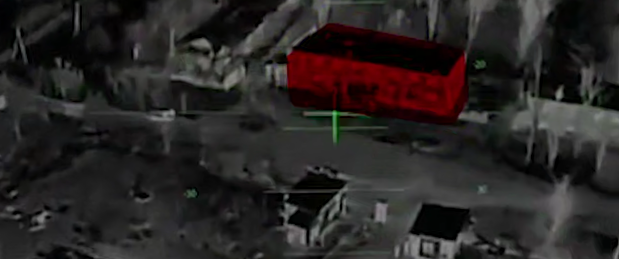
Earlier, LIGA.net reported that Russian military intelligence and Russian Defense Minister Andrei Belousov stand behind the Rubikon center, according to a Ukrainian Defense Intelligence officer with the callsign "Azimut".

The officer added that Rubikon shows “strong political will and a large role” of Russian special services directly in organizing this structure.
The intelligence officer also noted that elitism indeed exists within Rubikon. For example, recruiters for this unit have the right to take personnel from any units.
“They simply arrive — and have full access to pilots from other combined-arms units," said the officer.
Therefore, he noted, due to political will, this formation has “maximum opportunities for its development and maximum access to financing and technologies.”

Earlier, the Ukrainian Defense Intelligence reported that its soldiers had discovered the Rubikon base in Avdiivka, Donetsk Oblast. The city fell under Russian control in 2014.
Using precise coordinates of Russia's position, Ukrainian intelligence operators directed its new FP-2 unmanned aerial vehicle, equipped with a 105-kilogram warhead, toward the Russian target amid dense urban terrain.
As a result of the strike, Ukrainian Intelligence eliminated Russian officers and drone operators from the unit who were inside their headquarters.
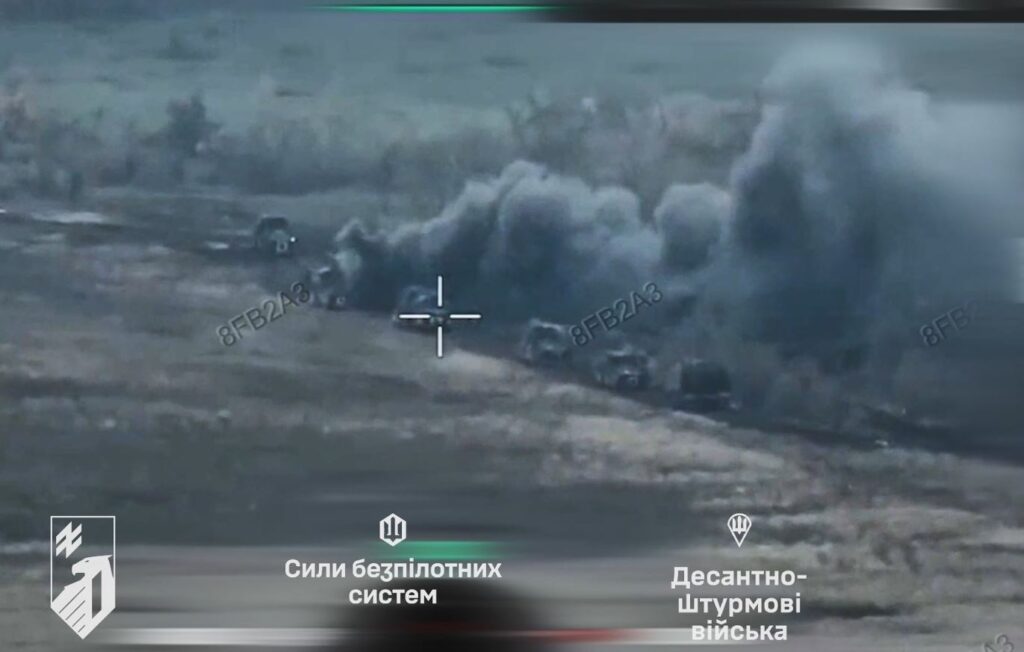
The Ukrainian 1st Azov Corps is mopping up the last Russian positions in a 40-square-kilometer salient north of Pokrovsk in Donetsk Oblast, winning a two-month battle that could free up hundreds—possibly thousands—of troops. Meanwhile, Pokrovsk itself is falling to Russian infiltrators after a yearlong siege, and 100 kilometers south, Russia's 90th Tank Division is advancing across open terrain toward the logistics hub of Huliaipole in Zaporizhzhia Oblast.
The victories north of Pokrovsk create a brutal dilemma: Ukrainian commanders can use these freed-up troops to buttress the new defensive line forming north of the fallen city—or rush them 100 kilometers south to Huliaipole, where Russia's 90th Tank Division is advancing across open terrain toward Zaporizhzhia.
Outnumbered five-to-one, they don't have enough troops to do both.
Counterattacks by the Ukrainian 1st Azov Corps since mid-August have steadily reduced a 40-square-kilometer salient that the Russian 132nd Motor Rifle Brigade had carved out of the front line north of Pokrovsk a few weeks earlier. The salient bent toward the village of Dobropillia, which sits astride one of the main supply lines into Pokrovsk.
Liberating the village of Kucheriv Yar late last month and defending the nearby village of Shakhove from repeated Russian mechanized assaults, Ukrainian forces have the momentum in the salient battle. Now they're killing, capturing, or forcing out the last few Russians.

The armed forces of Ukraine "are continuing to mop-up the Dobropillia salient, successfully recapturing several positions around the village of Shakhove," the pro-Ukraine Conflict Intelligence Team reported last week. "These successes may allow Ukrainian reserves to be redeployed from this sector to strengthen the Pokrovsk direction."
In other words, Russian commanders may have viewed the Dobropillia salient as a "counter-fixation axis for Ukrainian reserves," according to military theorist Delwin. The Russians devoted just enough troops and vehicles to the salient battle to keep the 1st Azov Corps fixated on fighting north of Pokrovsk—so the corps wouldn't shift its attention to Pokrovsk proper.
The problem, however, is that the Russians have the momentum in Pokrovsk—and it may be impossible for the Ukrainians, outnumbered five to one, to seize it from them. "Russian forces will very likely seize Pokrovsk and Myrnohrad," the Institute for the Study of War in Washington, D.C. concluded Tuesday.
The Russians succeeded in infiltrating Pokrovsk following a brutal yearlong siege in part because the salient battle drew the 1st Azov Corps into fighting north of Pokrovsk—keeping it from fighting in Pokrovsk, which was garrisoned by two exhausted Ukrainian units. The 68th Jaeger Brigade and 155th Mechanized Brigade began retreating north in late October.
Now that the 1st Azov Corps is on the verge of winning the salient fight, it's probably too late to do much for Pokrovsk. A few elite Ukrainian units, including one commando team that helicoptered into the city on 29 October, are clinging to fighting positions on the northern edge of Pokrovsk, holding open a narrow escape route for any Ukrainian troops still attempting to flee that city or neighboring Myrnohrad.
Pokrovsk, a once-thriving mining city of 60,000 people, is almost certainly lost—as is smaller Myrnohrad. The Ukrainian forces romping to victory in the disappearing Dobropillia salient may end up staying in the area, buttressing a new defensive line north of Pokrovsk.
Or they may head south to the junction of Donetsk, Dnipropetrovsk, and Zaporizhzhia Oblasts, where a powerful force led by the Russian army's biggest division, the 90th Tank Division, has been steadily advancing across unfortified open terrain, pushing back an outgunned and outnumbered Ukrainian force.
"Unfortunately, over the past few weeks, Russian forces have made a series of gains toward Huliaipole and, more broadly, achieved notable advances in the southeastern sector," explained Tatarigami, founder of the Ukrainian Frontelligence Insight analysis group.
Reinforcements could stiffen Ukrainian defenses around Huliaipole. But Ukrainian commanders must choose carefully where they send their precious few reserves.
Their choice to fight so hard over the Dobropillia salient may have hastened Pokrovsk's fall. Likewise, rushing troops south to Huliaipole could weaken the new defensive line forming north of Pokrovsk.
At the same time, stiffening that defensive line at the expense of Huliaipole could accelerate Russian gains in the south. As long as Russia has more troops than Ukraine has, there are no easy choices for infantry-starved Ukrainian commanders.
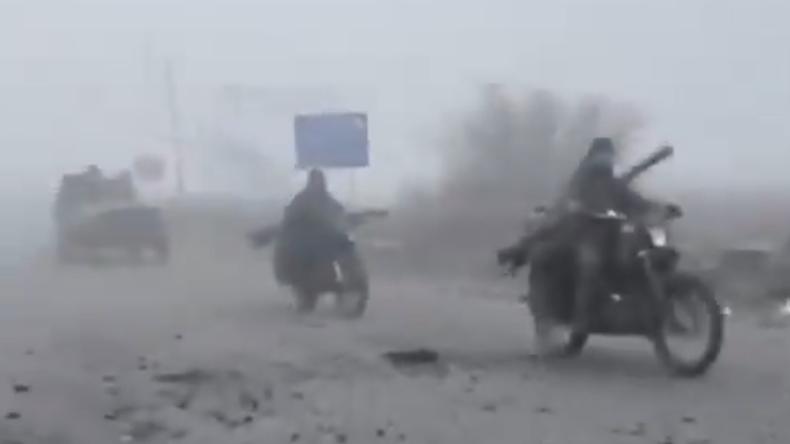
The overcast and foggy weather that rolled in with the winter months is an opportunity for Russian forces to rush infantry and vehicles across the drone-patrolled no-man's-land and secure new positions in Pokrovsk, Myrnohrad, and other contested settlements.
That's because bad weather means poor visibility for drones—and drones are now the main means of defense for infantry-starved Ukrainian formations.
If the drones can see, the Russians struggle to advance. If the drones can't see, the Russians advance quickly—and in large numbers.
This was dramatically evident this weekend. "During recent days, the Russians have intensified efforts to penetrate Pokrovsk on light equipment through the southern suburbs," the Ukrainian 7th Rapid Response Corps, which defends Pokrovsk and neighboring Myrnohrad, explained on social media on Tuesday.

"For this, the enemy used adverse weather conditions, including thick fog," the corps added. "This reduces opportunities for our aerial reconnaissance."
Videos from Pokrovsk during the stretch of bad weather depict dozens of Russian troops motoring into the city on bikes and in compact cars and trucks. Yes, videos also depict some Ukrainian drone strikes on the intruding Russians—but too few and too slow to halt the Russian advance.
"There are currently more than 300 Russians in the city," the 7th Rapid Response Corps warned. "Their goal remains unchanged—to reach the northern borders of Pokrovsk with a further attempt to surround the agglomeration."
The Russians were already creeping into Pokrovsk and Myrnohrad before the weekend fog, but much more slowly. Now with the advantageous weather, Russian forces have accelerated their advance dramatically—and the fragments of two Ukrainian brigades still in Myrnohrad face potential encirclement.
Video of Russian soldiers taking advantage of the fog to drive into southern Pokrovsk in motorcycles, Bukhanka, and other modified vehicles.https://t.co/vuNp68mHfAhttps://t.co/GrFY1bOmss pic.twitter.com/R3BDwRvnml
— Rob Lee (@RALee85) November 10, 2025
One Ukrainian drone operator has been warning for months—years even—that fog and other obscurants can blunt Ukraine's drone edge, assuming Russian commanders have the foresight to take advantage of the concealment.
"Need to say that Russian [paratroopers are] trying to use fog and a lot of smoke at the battlefield," drone operator Kriegsforscher reported a year ago. "And it really helps."
Four months later in March, the Russians continued to attack under the cover of smoke and fog in Kriegsforscher's sector. "I need to say that because of the smoke, it was hard for us to find them," the drone operator stated. "It's effective."
The fog that protected the Russians back in the spring is even thicker now. In late October, analyst Moklasen observed the Russian 336th Naval Infantry Brigade attacking toward the village of Dobropillia, just north of Pokrovsk.
336 naval infantry.
— imi (m) (@moklasen) November 10, 2025
late october, heavy fog -
bikers clear the road of munitions for turtle mtlb assaults toward dobropillia, & bike casevac pic.twitter.com/eOTUuQHBMT
"Heavy fog," Moklasen observed. The concealment allowed Russian bike troops to sweep a road of Ukrainian munitions and clear a path for up-armored Russian vehicles to assault toward Dobropillia while the bikers fetched the wounded and sped them back toward Russian lines.
Dobropillia remains in Ukrainian hands despite the foggy Russian attacks, but the same can't be said of Pokrovsk and Myrnohrad. After a yearlong siege, the settlements are on the cusp of falling to the larger Russian force.
The loss underscores an important truism. Infantry can fight through fog in a way drones can't, but Ukraine has too few infantry to fill the aerial gaps when the drones can't fly or see.
"Drones and artillery help, but infantry still matters," Finnish analyst Joni Askola explained. "You need soldiers to hold ground. Ukraine does not have enough."
Why Ukrainian troops are vulnerable to foggy weather:

Foreign ministers from the Group of Seven (G7) nations convened in Niagara-on-the-Lake, Canada, on 11-12 November 2025, for tense discussions on global security.
The talks are dominated by Russia's escalating war in Ukraine, stalled US-led peace initiatives, and growing trade frictions within the alliance.
The gathering comes as the G7 confronts a dual challenge: maintaining a united front against Russian aggression while navigating sharp internal divisions over US trade policies and defense spending demands.
The summit opened amid clear divisions on how to handle the war in Ukraine. Most G7 members have adopted a tougher line on Russia than US President Donald Trump, who has prioritized his own peace proposals. German Foreign Minister Johann Wadephul stated before the meeting that Russia's "continuing war of aggression against Ukraine" challenges global freedom and security, requiring a united G7 front.
According to a report from Euronews, European allies are particularly concerned about uncertainty over US efforts to end the war, as well as a separate US-brokered ceasefire plan in Gaza that is reportedly faltering.
The German foreign minister emphasized that his country is providing an additional €40 million to help Ukraine endure another winter, specifically to counter Russia's "targeted terror attacks on the civilian gas and heat supply." This financial support directly translates into tangible resilience, helping Kyiv maintain civilian morale and infrastructure stability—a strategic goal to prevent Russia from breaking the country's spirit.
The talks were also marked by strained relations over US trade policy. As reported by The Associated Press, President Trump's imposition of tariffs on Canadian imports has created friction with the host nation. This economic pressure is coupled with Trump's demand that NATO partners, including all G7 members except Japan, spend 5% of their GDP on defense.
The AP noted that Canada and Italy are the furthest from this goal, though Canadian Foreign Minister Anita Anand stated Canada plans to reach the target by 2035. In a social media post, US Secretary of State Marco Rubio framed the US position, stating the focus is on "putting the safety and security of Americans FIRST."
While Ukraine and trade dominated, the ministers also addressed long-term strategic challenges, particularly in the Indo-Pacific. Kyodo News reported that Japan's new Foreign Minister, Toshimitsu Motegi, planned to "bring an Indo-Pacific perspective into G7 discussions and advance concrete cooperation."
A central part of this strategy is a G7 initiative to establish alternative supply chains for critical minerals to diversify away from China’s market dominance. This effort is a direct attempt to bolster the G7's economic and defense security by mitigating reliance on geopolitical competitors, a crucial step in the world's current volatile geopolitical situation.

Ukraine's National Anti-Corruption Bureau (NABU) revealed on 10 November 2025 an intricate corruption scheme at Energoatom: unvetted operatives wielding control over the country's state nuclear company through systematic bribery. Over 1,000 hours of surveillance recordings and 70 nationwide raids documented how these external actors, without formal positions, made critical decisions affecting the strategic enterprise.
The investigation, dubbed Operation Midas, targeted businessman Timur Mindich, co-owner of President Volodymyr Zelenskyy's former comedy studio Kvartal 95, along with Justice Minister Herman Halushchenko, who previously served as energy minister, and several Energoatom executives, according to Ukrainian outlet NV.
MP Yaroslav Zhelezniak said Mindich left Ukraine hours before NABU officers arrived and "will be hiding in Israel and Austria," Interfax Ukraine reported.
The evidence is stark: video and audio recordings show Energoatom contractors openly discussing bribe percentages—10 to 15 percent of contract values, investigators found. They call it "Shlagbaum," or boom barrier, slang for an obstacle designed to extract payments.
The scheme was ruthlessly systematic: prosecutors say bribes were demanded in exchange for avoiding blocked payments or loss of supplier status."In fact, management of the strategic enterprise with annual revenue of over $4.7 billion was carried out not by official employees, but by outsiders who had no formal authority, yet took on the role of 'watchers,'" NABU specialists said.
The recordings capture conversations about halting critical infrastructure protection projects—not for engineering reasons, but over monetary disputes about kickback rates.
The operation zeroed in on a network of officials and businessmen, including:
Energy Minister Svitlana Hrynchuk also faces dismissal calls over alleged connections to the scheme.
The scandal has triggered immediate fallout. Parliament member Zheleznyak branded it "systemic corruption" demanding action, and dismissal requests for Galushchenko and Hrynchuk face Parliamentary vote.
Ukraine's Security Service (SBU) is separately investigating Mindich for "assistance to an aggressor state" based on allegations about diamond extraction and sales operations in Russia during the full-scale invasion, Interfax Ukraine reported. SBU's Main Investigation Department confirmed on 6 November 2025 that it opened criminal proceedings under Article 111-2 of Ukraine's Criminal Code.
The alleged corruption occurred while Ukraine's energy infrastructure faced systematic Russian missile and drone attacks. As a state enterprise managing nuclear power operations with annual revenues exceeding $4.7 billion, Energoatom's procurement and staffing processes offered lucrative opportunities for corrupt actors.
"Corruption in the energy sector, money laundering, illegal enrichment," Oleksandr Abakumov, head of NABU's detective unit, outlined as the main directions of the large-scale investigation, NV reported.
Diverting funds meant for nuclear safety and infrastructure projects creates vulnerabilities that could compromise defense readiness and undermine public trust in government accountability during wartime.
NABU has not publicly identified all participants in the alleged criminal organization. Prosecutors say audio and video evidence will support further prosecutions as the investigation expands.
The case is seen as a critical test for Ukraine's anti-corruption infrastructure. Western governments have previously defended NABU's independence, viewing such enforcement as essential to Ukraine's European integration path and its ability to maintain international support.
The investigation also raises serious governance questions for Energoatom. Before the full-scale invasion, the company generated approximately half of Ukraine's electricity. With the six-reactor Zaporizhzhia Nuclear Power Plant under Russian occupation since March 2022, the integrity of the company's remaining operations is paramount.
Read also:
Flamingo does combat trials as Ukraine inches towards wider use
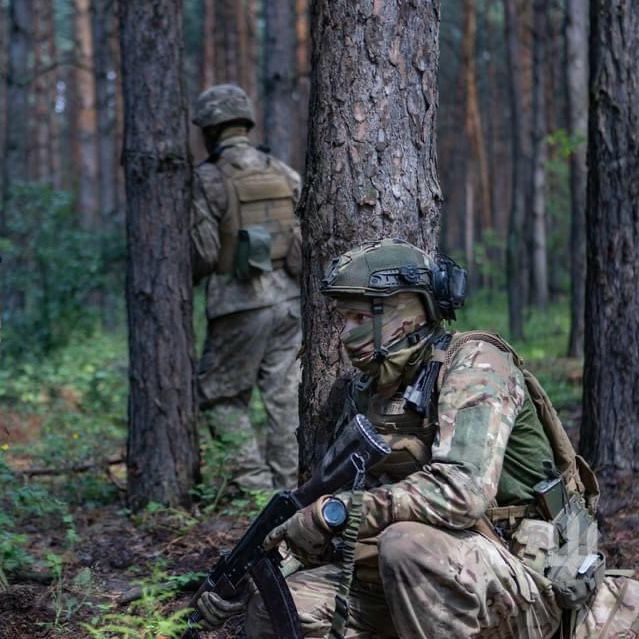
The Russian army is becoming a degraded structure that is collapsing from within. During 2024–2025, due to service negligence, alcohol and drug overdoses, fights, and unsanitary conditions, more than 600 soldiers of the Russian Central Military District died, Ukraine's Defense Intelligence says in a new report.
This district is one of the five operating within the occupation army.
It is noted that in 2024, at least 71 soldiers committed suicide, and in the first half of 2025, 86 soldiers and officers took their own lives.
“Meanwhile, the low quality of food in the military units of the district led to the death of 32 occupiers from food poisoning,” the agency says.
Drugs are also killing the Russian Army. In less than 2025, 112 cases of death from drug poisoning were recorded, almost reaching the 2024 number, when 143 people died from the intake of substances.
"The rise in suicides, crime, and drug abuse among Russian military personnel is a sign of deep demoralization of the occupation contingent," the Defense Intelligence added.
Earlier, the Ukrainian Prosecutor General’s Office reported that Ukraine has registered over 190,000 war crimes since the start of Russia’s all-out war in 2022.
The prosecutors believe the scale and pattern of these crimes show a state-directed campaign to wipe out the Ukrainian nation. Deputy Prosecutor General Andrii Leshchenko called it "a deliberate genocidal policy" of Russia.
Notes dictées lors d’une balade le 15.08.2025, laborieusement remises un peu au propre presque trois mois plus tard. Même si la situation a évolué depuis, c’était un moment que je voulais capturer.
Quand on vit seul, on n’a personne pour nous dire : “viens, on va aller se promener”, ou bien “viens, on va au cinéma”, ou bien « ok, maintenant on sort, prépare-toi, on prend la voiture, on va aller au bord du lac, on va rendre visite à tel-et-tel, on va aller à la montagne, on va faire ceci, faire cela ».
On n’a personne d’extérieur qui nous voit au quotidien, qui peut donc nous aider à sortir d’une éventuelle spirale un peu vicieuse, genre on en fait moins, on en fait donc encore moins… Ou bien, on n’a pas le moral, donc on fait moins, ou bien on est fatigué, donc on fait moins. Mais des fois, bouger, ça réénergise. Parfois c’est le contraire qu’il faudrait, comme ça m’est arrivé, quand je suis restée coincée pendant des jours à faire du troubleshooting pour mon réseau Wi-Fi. On n’a pas une personne qui est là pour dire : “ok, maintenant stop, ça suffit, t’as fait assez, lâche ce machin et viens regarder un film avec moi.”
Pour quelqu’un comme moi (allô TDAH) toute la partie fonctionnement exécutif bat un peu de l’aile de base. Le fonctionnement exécutif ça comprend, entre autres, la gestion des activités, du temps, des tâches. C’est donc quelque chose qui est déjà compliqué pour moi, qui me demande de l’énergie, des stratégies de compensation, et qui me fatigue.
Ces problématiques que j’ai déjà sont aggravées par la commotion. La commotion, c’est une blessure au cerveau. Elle ne se voit pas, il n’y a rien au scanner, et les mini-dégâts physiques invisibles sont réparés, depuis le temps. Mais le cerveau, c’est fonctionnel, pas juste structurel. Même si physiquement “il n’y a rien”, le syndrome post-commotionnel signifie que j’ai plus de difficultés d’attention, de concentration, d’endurance, de fatigabilité.
Donc vous voyez le problème. Je dois gérer la bonne quantité d’activités, mais c’est déjà quelque chose qui est compliqué en temps normal, et là je n’ai même plus les ressources habituelles dont j’ai besoin pour faire ça. Du coup, ça me fatigue encore plus.
Cela veut dire que je vais peut-être avoir un moins bon programme de récupération, je vais moins bien réussir à équilibrer mes activités, me reposer quand j’ai besoin de me reposer, être active quand j’ai besoin d’être active — parce que le travail qu’il faut faire, justement, pour gérer ça, c’est une des choses que j’arrive moins bien à faire. Et qui me fatigue. C’est le serpent qui se mord la queue.
Quand on vit seul, on est donc seul à se dépatouiller avec ça. J’ai des amies, mais elles ne vivent pas avec moi, donc elles ne me voient pas au quotidien. Elles ne sont pas là pour me dire “stop” ou “allez, viens”.
Vivre seul, ça vient en fait avec un gros risque de perte de chance face à des atteintes dans notre santé qui impactent justement notre capacité à nous gérer. Même quand on est entouré — et je le suis, j’ai des amis, j’ai plein de gens qui ont répondu présent pour venir m’aider après l’accident, etc. Mais c’est quand même largement moi qui dois mobiliser ces ressources, et j’ai la chance d’avoir la capacité de le faire (mais pas toujours).
J’apprécie d’ailleurs infiniment les quelques amis qui me proposent des choses, qui me disent : “voilà, je viens, je pourrais venir tel jour pour souper avec toi, je pourrais venir à tel moment…” Des fois ça ne va pas toujours, des fois je dis non, mais ils·elles continuent.
Et ça, en fait, surtout maintenant, alors qu’on approche des 5 mois post-accident, c’est précieux, parce que ce n’est pas facile non plus de demander de l’aide.
Les difficultés auxquelles je fais face, eh bien elles ne sont pas forcément visibles. Quand on me voit, ça ne se voit pas. Ça passe inaperçu.
Donc je dois penser à le dire, je dois le verbaliser, je dois réussir à faire passer le message. Ce n’est pas forcément évident de faire passer le message qu’on galère à s’organiser, par exemple, quand ce que les gens voient de l’extérieur, c’est quand même qu’on ne gère pas si mal. En plus, on a l’air d’être toujours la même personne qu’on a été — on l’est largement, mais pas tout à fait. Ce n’est pas simple.
Et particulièrement ces temps, je trouve que c’est de moins en moins simple aussi de garder le moral.
Après l’accident, il y a le choc, et tout. Ensuite, le début de la récupération, c’est assez rapide. Bien sûr, il y a des hauts et des bas, ce n’est pas linéaire une récupération.
Et puis plus on avance, plus la récupération est lente, moins les progrès sont visibles. Plus on est proche de la normalité, moins ça se voit qu’on galère encore. Et donc moins on a d’opportunités d’être entendu par rapport à ça, de se sentir vu ou compris.
Donc là, je trouve dur de rester positive, de ne pas me laisser embarquer dans des spirales d’inquiétude. Est-ce que je vais vraiment réussir à retravailler ? Le neurologue n’a pas changé d’avis là-dessus. Il n’y a pas de raison. On ne peut jamais rien garantir à 100 %, mais il n’y a pas de raison que je ne fasse pas une récupération complète.
Mais il reste des choses au quotidien qui me font peur. Laisser la clé dans le contact dans la voiture parquée en plein centre-ville quand je pars souper au restaurant. Des trucs qui m’échappent. Des maladresses qui sont, à mon avis, attentionnelles. Pas moteurs — attentionnelles. D’ailleurs on le voit bien : laisser échapper un truc qu’on vient de scanner à la Migros et laisser la clé dans la voiture, il y en a un où on pourrait effectivement se dire que c’est moteur, mais pas l’autre.
J’ai l’impression qu’il y a toute une série de stratégies que j’ai en place depuis des décennies pour fonctionner, qui marchaient tellement automatiquement que je ne me rendais pas compte qu’elles étaient là. Et qu’elles fonctionnaient au niveau où elles fonctionnaient parce que je les entrainais en permanence.
Comment éviter ces incidents d’un genre nouveau pour moi ? Ce qui était déjà un peu limite avant, ou que je savais que je gérais/compensais, les choses pour lesquelles je savais que je devais être prudente avant, ça va. Je peux être plus prudente.
J’essaie de trouver des exemples qui pourraient parler à d’autres personnes que moi. Imaginons… je ne sais pas… imaginons que vous êtes quelqu’un qui n’oublie jamais ses clés, ou qui ne perd jamais ses clés. Ça ne fait simplement pas partie de votre vie, des choses qui pourraient vous arriver.
Un beau jour, vous perdez ou oubliez vos clés. Une fois. Vous pouvez vous dire « ah, merde, pas de chance ». Combien de fois vous faudra-t-il perdre vos clés pour vous dire « oh, il faut dorénavant que je fasse vraiment attention et que je mette en place des stratégies de compensation pour ne pas perdre ou oublier mes clés » ?
Une fois que l’incident est arrivé, on se dit : bon alors ok, la clé dans le contact de la voiture, ça, c’est assez simple à prévenir. Ça m’est arrivé, et c’est vrai que j’avais déjà eu un ou deux signaux d’alerte par le passé, des fois où je suis sortie de la voiture en laissant la clé dans le contact. J’avais d’ailleurs identifié que c’était des situations où j’étais en train d’écouter quelque chose, que je voulais continuer à écouter, et donc on comprend aisément que l’oubli puisse avoir lieu, mon attention étant ailleurs.
Dans ce cas, je peux mettre en place une stratégie. Je crée une sorte de “règle” : j’arrête la voiture, j’enlève la clé du contact, je la mets dans la poche. Facile.
Renverser des trucs, c’est moins facile d’y remédier. Faut-il porter chaque chose comme si elle était une chose fragile et précieuse? Faut-il mesurer chaque geste du quotidien? Jusqu’où aller?
Ce qui est difficile aussi avec cet accident, enfin, avec les changements depuis l’accident (même s’ils ne sont pas énormes), c’est que c’est venu d’un coup.
Quand on vieillit, et que petit à petit nos capacités physiques et cognitives diminuent, doucement, ce n’est pas du jour au lendemain. On se rend donc compte des changements et des adaptations à apprivoiser, petit à petit. Avec la quarantaine, la périménopause, je vois déjà bien ce processus. On se dit: “mais purée, ça m’arrive de plus en plus souvent de faire des erreurs ou d’oublier quelque chose, avant ça m’arrivait jamais.”
Donc voilà. Petit à petit, on s’habitue. Petit à petit, on adapte notre image de nous.
Mais là, c’est comme s’il y avait une mise à jour du système d’exploitation du téléphone suite à laquelle il y a des trucs qui ne marchent plus. Avant, ça marchait tout le temps, mais maintenant, ça ne marche plus. De temps en temps, il y a des gros bugs.
Tenez, un autre truc automatique qui ne marche plus aussi bien post-accident: c’est le calcul mental.
Exemple très concret. Je me dis OK, je vais faire deux heures de promenade, je regarde sur Swisstopo une destination qui est à 45 minutes, et je me dis, ah mais non, ça va faire trop loin pour être de retour en une heure, donc je trouve un objectif à 25 minutes pour faire une boucle d’une heure — alors que c’était en fait deux heures. J’ai divisé par deux une fois.
Ou alors, comme l’autre jour, je fais 4 + 2 + 3 = 7.
Ce genre de truc. C’est quand même flippant.
Un autre exemple: je regarde les résultats du Bol d’Or, je lis 1h30 pour les vainqueurs — en fait c’était 1h30 du matin — et j’enregistre dans ma tête qu’ils ont mis 1h30 pour faire l’aller-retour du Bal d’Or, ce qui est totalement impossible. Mais je ne réalise pas que c’est complètement impossible, et je répète même cette “info mal interprétée” à quelqu’un.
C’est comme s’il y avait une sorte de processus de vérification ou de validation des chiffres qui n’est plus là, ou qui n’est plus aussi bien là, ou qui bugue. Ça, c’est super chiant et déstabilisant.

The yearlong siege of Pokrovsk is coming to an end. At the same time, the three-month battle for the Dobropillia salient, a few kilometers north of Pokrovsk, is also coming to an end.
It may not be a coincidence. It's possible the Russians have fought just hard enough around Dobropillia to tie down Ukrainian reserves who otherwise might have rushed south and reinforced Pokrovsk.
In other words, Russian commanders may have viewed the Dobropillia salient as a "counter-fixation axis for Ukrainian reserves," according to military theorist Delwin. The tactic—known as a counter-fixation axis—works by threatening a secondary objective to pin down enemy reserves, preventing them from reinforcing the primary target. The Russians may have committed just enough forces to the salient battle, primarily from a quintet of marine brigades and regiments, to keep the Ukrainian 1st Azov Corps busy ... and keep it out of Pokrovsk.
Delwin's theory makes some sense, and could serve as a warning for Ukrainian commanders as the Ukrainian garrisons retreat from Pokrovsk and neighboring Myrnohrad and the campaign for Donetsk Oblast enters a new phase. That warning is simple: expect deception and diversion.
The timing of the fall of the remainder of the Dobropillia salient strangely coincides with the closing of the Pokrovsk pocket.
— Delwin | Military Theorist (@DelwinStrategy) November 6, 2025
Russian forces have offered little resistance since the surrender of Kucheriv Yar. It seems this was planned as a counter-fixation axis for Ukrainian… pic.twitter.com/4hEYUIINVM
When the Russian 132nd Motor Rifle Brigade discovered gaps in the undermanned Ukrainian line north of Pokrovsk and swiftly marched 15 km toward the village of Dobropillia back in early August, they initially aimed to gain fire control over the village—and pummel it with drones and artillery.
And for good reason: one of the two main supply lines into Pokrovsk threaded through Dobropillia. Severing that supply line could've accelerated the starvation of the two Ukrainian brigades in the Pokrovsk garrison.

But the Ukrainians reacted swiftly, deploying the 1st Azov Corps and several of its well-equipped brigades. The Ukrainians squeezed the 40-square-kilometer salient from both sides, forcing the Russians away from Dobropillia proper and surrounding them in at least two groups, including one in the village of Kucheriv Yar.
Meanwhile, the Ukrainian 225th Assault Regiment and 33rd Mechanized Brigade established a strong defense in the village of Shakhove, which anchored the southeastern corner of the salient. The defenders of Shakhove rebuffed repeated Russian mechanized assaults, preventing heavy Russian reinforcements from entering the salient.
In late October, the Ukrainian 132nd Reconnaissance Battalion liberated Kucheriv Yar, taking Russian prisoners and eliminating around half of the salient. North of Pokrovsk, the momentum was on the Ukrainians' side as they eliminated the two-month-old incursion and straightened their line.
Farther south in Pokrovsk and Dobropillia, however, the Russians had the momentum.
Russian regiments failed to captured Dobropillia, but they still managed to put pressure on the supply lines into Pokrovsk and Myrnohrad by pushing drone teams as close as possible to the front line.
Russian infiltrators slipped into Pokrovsk from the south, suffering enormous casualties but managing, slowly yet steadily, to accumulate enough forces inside Pokrovsk to destabilize the increasingly outnumbered and outgunned Ukrainian garrison.
When the Ukrainian Tymur Special Unit staged a daring helicopter assault into Pokrovsk on 29 October, it wasn't a sign the Ukrainians were winning in the city. Quite the opposite.
The Tymur commandos were part of a wider Ukrainian effort to hold a few key fighting positions in northern Pokrovsk—and keep open an escape route for the last survivors of the city's garrison.
"The battle for the city is coming to an end," observer Thorkill concluded on Wednesday.
We may never know how much longer the city may have held if the Russians hadn't occupied the 1st Azov Corps in a long battle around Dobropillia. But it surely helped the Russian strategy in Pokrovsk that the 1st Azov Corps never fought in the city itself.
The Russians' apparent plan worked. And it may have worked even better if, for example, those mechanized columns had been able to get past Shakhove and bolster the Dobropillia salient. A harder fight over the pocket could've drawn in even more Ukrainian units, further weakening defenses in and adjacent to Pokrovsk and Myrnohrad.
"Overall, Russian commanders in charge of the operation cannot be overly praised," Delwin wrote, "as they should have exploited this further."

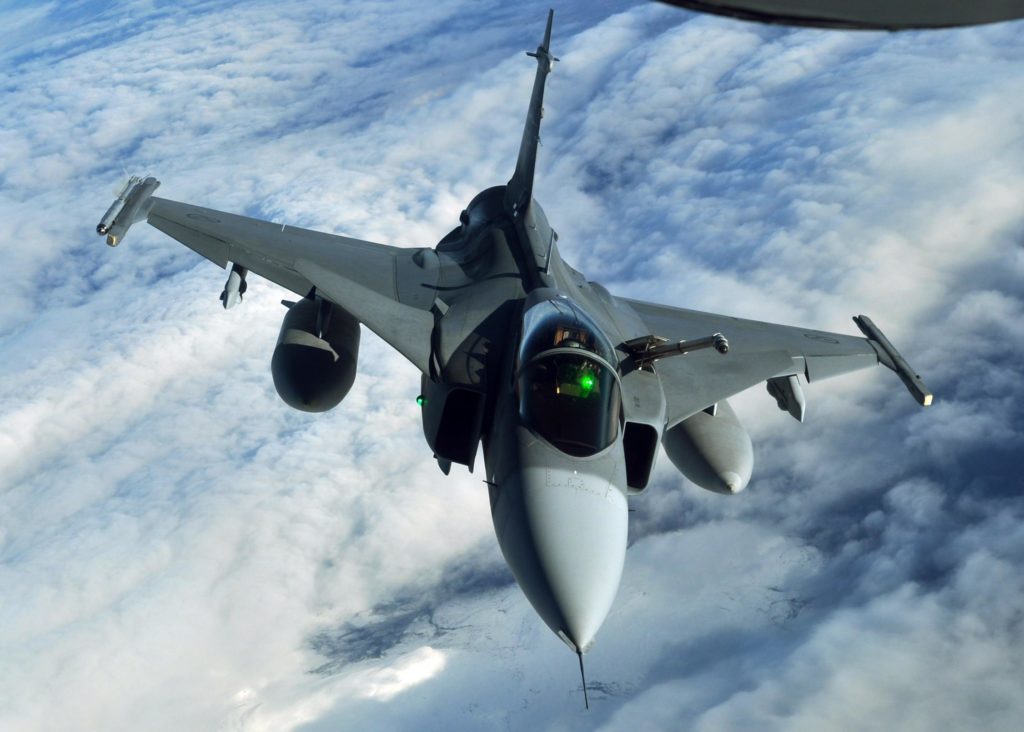
Ukraine may replicate Brazil’s model for localizing production of the Swedish JAS 39 Gripen E/F fighters. The first domestically assembled aircraft could appear as early as 2034–2035, according to Defense Express.
The Gripen E is a 4++-generation multirole fighter capable of speeds up to Mach 2, equipped with advanced radar, AIM-120 AMRAAM and AIM-9 Sidewinder missiles, and precision strike capability.
According to Defense Minister Denys Shmyhal, assembly is planned under the Brazil model to begin in 2033, with Ukrainian defense industry involvement gradually expanding, starting from kit assembly and moving toward manufacturing individual components directly in Ukraine.
Preparatory work, including the establishment of new production lines and training of specialists, is scheduled to start by 2030. Initially, assembly will rely on kits, with full-cycle production to be rolled out later.
The first 22–24 Gripen E/F fighters will be produced directly by Saab in Sweden, while the remaining approximately 125 aircraft will be assembled in Ukraine.
If a formal agreement with Saab is signed in 2026, deliveries of the first jets from Sweden are expected to begin around 2035. Preliminary calculations suggest that full production of 150 fighters could be completed between 2045 and 2050.
The first Gripen aircraft to arrive in Ukraine will be used Gripen C/D jets, which Sweden plans to deliver in 2026. These aircraft will provide an interim rearmament stage for the Air Force before production of the new E/F version begins.
Experts emphasize that the Gripen E/F will become Ukraine’s primary combat aircraft for decades.
“Gripen is the aircraft that Ukrainian pilots will be flying well into 2070 and beyond,” the analysts predict.
Saab is also reportedly exploring options for a parallel production line in Canada due to growing international demand.
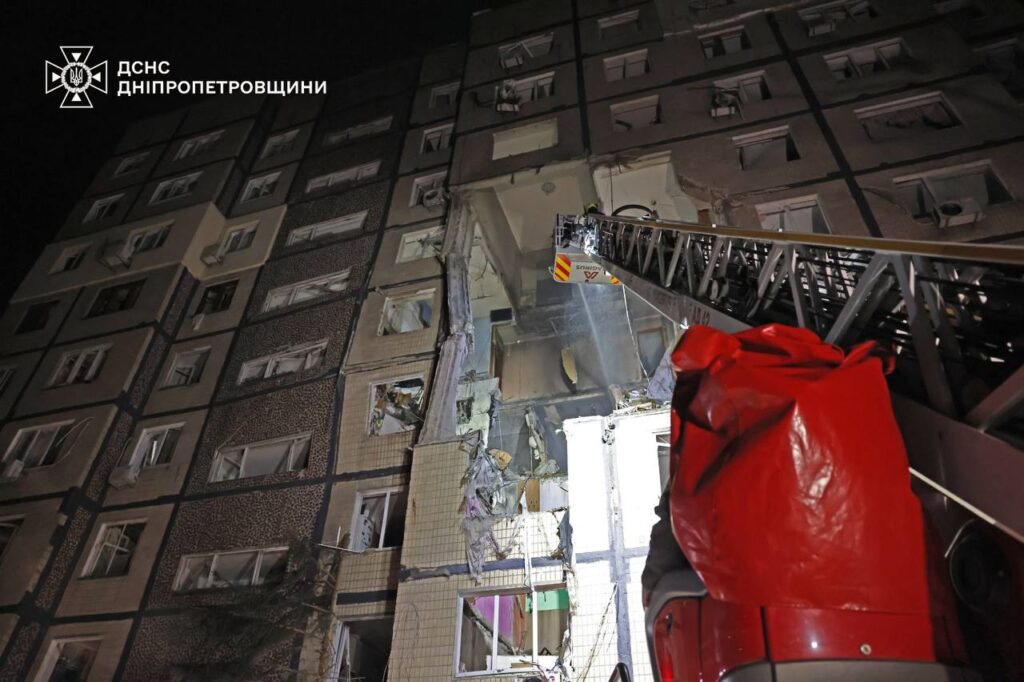
Ukraine is paying a terrible price for its resistance to Russia's genocide war and occupation. On the night of 8 November, all of Ukraine came under fire. The Russian army launched over 450 attack drones and 45 missiles, targeting residential buildings and energy infrastructure across the country.
According to Centrenergo, a company supplying electricity to central and eastern Ukraine, its three thermal power plants have been forced to shut down following the attacks. Eight regions are facing widespread power outages, and in Kyiv, residents are left without electricity for up to 12 hours a day.
In Dnipro, a drone strike on a residential building killed three people.
President Volodymyr Zelenskyy said the attacks must trigger a unified global sanctions response.
“Every strike by Moscow on our energy sector must be met with sanctions on the entire Russian energy sector, without exception. Nuclear energy, the military-industrial complex, and trade in oil and gas must all be under sanctions," Zelenskyy claimed.
He emphasized that the world must act on frozen Russian assets and increase support for Ukraine to prevent the Kremlin from destroying the country’s civilian energy system before winter.
According to Air Force spokesperson Yurii Ihnat, Russia used a record number of ballistic missiles in this latest strike, per 24 Channel.
“Twenty-five Iskander-M/KN-23s and seven Kinzhal missiles. A total of 32 missiles followed ballistic trajectories. This is Russia's new tactic," he said.
The main strikes hit the regions of Kharkiv, Kyiv, Poltava, Dnipro, Kirovohrad, Mykolaiv, Sumy, Chernihiv, and Odesa.
Ukrainian rescuers carried a girl out of damaged building in Dnipro after Russian drone crashed directly into it
— Euromaidan Press (@EuromaidanPress) November 8, 2025
Three people were killed, while others were thrown from their beds and pinned under window frames by blast wave. Russia ruined 111 apartmentsSuspilne Dnipro pic.twitter.com/RjAZfAi8Se
Naftogaz CEO Serhii Koretskyi said the 8 November strike was the ninth deliberate attack on civilian gas infrastructure since early October.
“This is yet another act of terrorism aimed at depriving Ukrainians of gas, heat, and electricity during the winter," said the head of the the largest national oil and gas company of Ukraine.
On the eve of the strikes, Ukraine signed an agreement to import US liquefied natural gas (LNG) via Greek terminals. According to the Ministry of Energy, the deal represents a long-term partnership through 2050, ensuring stable gas supplies and integrating Ukraine into European energy routes.
“We are building a resilient system for the delivery and storage of American gas to prevent Moscow’s energy blackmail,” said Energy Minister Svitlana Hrynchuk.
The Kremlin is now operating even more clinically and cynically than before. Russian capabilities and tactics are evolving faster than Ukraine can improve its air defenses, both missile interceptions and electronic warfare measures around sensitive sites. It appears this winter will be a test of endurance like no other.
The Kremlin has changed the way it is terrorizing Ukrainians when temperatures are going low, by concentrating on specific regions, striking in waves, and using new variants of cheap Shahed drones.
The drones are also attacking differently, approaching from near‑vertical trajectories and flying above the effective range of machine guns, almost like missiles.
Beyond the cost of damaged infrastructure, recent attacks are forcing Ukraine to spend a staggering $1.9 billion on imported gas.
Experts warn that this winter could be one of the toughest in Ukraine’s history. The world’s response will determine whether the aggressor can be contained or whether the global community allows the destruction of sovereign nations by force.
Follow Euromaidan Press on Google News! YOUR SUPPORT = OUR VOICE
A Ukrainian court sentenced a Russian soldier to life in prison on 6 November for executing a surrendered Ukrainian prisoner of war—the first such ruling in Ukraine's history. The verdict exposes a pattern documented throughout 2025: Russia systematically tortures, kills, and conceals Ukrainian POWs from monitors, while international bodies report Ukraine provides Russian captives with medical care and unrestricted UN access.
Dmitry Kurashov, 27, shot 41-year-old veteran Vitalii Hodniuk at point-blank range in January 2024 after Hodniuk ran out of ammunition and laid down his arms, according to Ukraine's Security Service (SBU). Ukrainian forces captured Kurashov later that same day. He had been recruited from a Russian prison to serve in a "Storm-V" assault unit, Suspilne reported.
The Zaporizhzhia court conviction arrives as three major international investigations—by the OSCE, Amnesty International, and the UN Human Rights Monitoring Mission—published findings throughout 2025 documenting systematic Russian violations of international humanitarian law.
The reports describe a deliberate policy architecture: torture as routine practice, enforced disappearances to prevent accountability, manipulation of international monitors, and denial that captured Ukrainians qualify as prisoners of war at all.
The contrast with Ukraine's treatment of Russian prisoners could hardly be sharper. While Russia conceals captives and blocks monitor access, Ukraine maintains established internment facilities with full UN oversight.
Kurashov's execution of Vitalii Hodniuk is far from an isolated case. Radio Free Europe/Radio Liberty reported another case: 33-year-old Ukrainian National Guard soldier Vladyslav Nahornyi, captured near Pokrovsk in August 2025. Russian forces took him and seven other Ukrainian soldiers to a basement, hands tied behind their backs.
From his hospital bed, unable to speak after Russian forces slit his throat, Nahornyi described in written notes what happened next. The reconnaissance soldiers captured first had their eyes gouged out, lips cut off, ears and noses removed, male organs mutilated. Then Russians cut all their throats and threw them into a pit. Nahornyi was the only survivor. Using a broken glass bottle, he cut his bindings, bandaged his throat, and crawled for five days to Ukrainian positions.
His survival suggests many more Ukrainian soldiers may have been killed or tortured to death immediately after capture. Not officially recognized as prisoners of war, they never stood a chance at survival. The case exemplifies the summary violence toward Ukrainians that has become standard practice by Russian forces.
Amnesty International's March 2025 report "A Deafening Silence" documented torture methods used systematically across Russian detention facilities. Researchers interviewed dozens of former Ukrainian POWs and civilian prisoners who described remarkably consistent patterns: immediate torture upon capture, electric shocks, beatings severe enough to cause death, denial of medical care, and prolonged isolation designed to break prisoners psychologically.
Russian authorities use torture not primarily for interrogation but as punishment and intimidation. Many prisoners described being tortured even after providing all requested information. The goal appears to be inflicting maximum suffering rather than extracting intelligence.
Enforced disappearance emerged as another systematic practice. Russia refuses to acknowledge holding many Ukrainian prisoners, making it impossible for families to locate them or for international monitors to verify their treatment. Some prisoners remain "disappeared" for months before Russia acknowledges their captivity—if it ever does.
An OSCE expert mission presented findings on 25 September revealing how Russian authorities stage-manage International Committee of the Red Cross visits. Moscow allows access only to select prisoners in relatively good condition while concealing others entirely, creating a false impression of compliance with Geneva Convention requirements for neutral monitoring.
The OSCE mission documented that Russian forces refuse to recognize captured Ukrainian military personnel as POWs at all, instead designating them as "persons detained for countering the special military operation." The same designation is used for detained Ukrainian civilians. Hence Russia treats them in criminal courts as "terrorists."
This classification, though completely fictitious and nonsensical, strips them of Geneva Convention protections and provides Russia with a legal pretext for abuse that would otherwise be clearly prohibited under international humanitarian law.
The report found that Russia routinely subjects Ukrainian military personnel to torture and summary executions, and maintains a system designed to prevent accountability. These policies may constitute war crimes and crimes against humanity under international law.
The UN Human Rights Monitoring Mission operates with "unfettered access" to Russian POWs held in established Ukrainian internment facilities. International monitors can visit any facility, interview any prisoner, and verify conditions without restriction—the standard required under the Geneva Conventions but systematically violated by Russia.
A March 2025 investigation by ZMINA.info examined why Amnesty International's major report on POW treatment focused exclusively on Russian violations. The answer was straightforward: Amnesty International Ukraine's separate study found Russian POWs in good physical condition receiving appropriate medical treatment. There was no pattern of systematic abuse to document.
Read also:
Ukraine documents 190,000 war crimes — and believes they prove Russia's plan to erase the nation
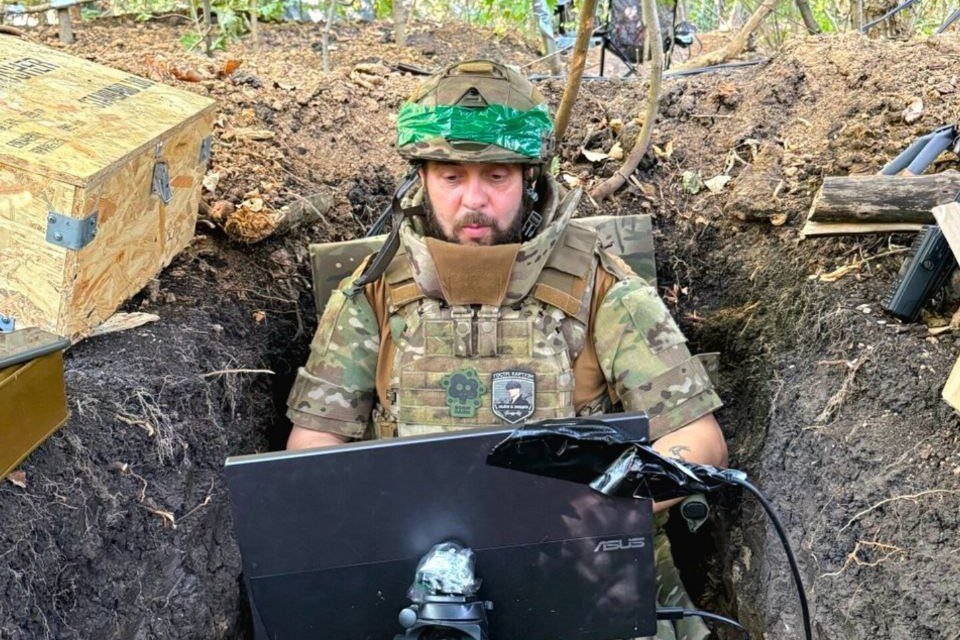
A thick fog blanketed Pokrovsk and neighboring Myrnohrad on Thursday. For the Russians, it was a long-awaited opportunity—to rush more forces past Ukraine's drones and into the embattled settlements.
They succeeded more than they failed. For the first time since the Russian Center Group of Forces arrived on the outskirts of Pokrovsk around a year ago, the Russians managed to get a vehicle into Pokrovsk. A truck.
That truck's crew immediately got to work removing obstacles from a road on the southern edge of Pokrovsk. Potentially clearing the way for more Russian vehicles to motor into Pokrovsk as the long, bloody battle for the city enters its final phase.
A surveillance drone from Ukraine's Peaky Blinders unit managed to get a clear view of the truck. But it seems conditions were too nasty for attack drones to strike the vehicle. "Unfortunately, the bad weather is now playing into the hands of the occupier," Peaky Blinders reported.
"If earlier we saw the infiltration of Russian troops into Pokrovsk exclusively on foot," the drone unit added. "At most, there were sometimes attempts to break through on a motorcycle. Today, through the fog, we noticed the first Russian military pickup in the city. They took their time throwing down the barricades and drove through the streets of Pokrovsk."
Video from the Ukrainian National Guard's Peaky Blinders unit of a Russian truck in Pokrovsk.https://t.co/45Uorz9knn pic.twitter.com/FwPp9ozTZm
— Rob Lee (@RALee85) November 6, 2025
Key developments in Russia's Pokrovsk offensive
The truck's arrival was a long time coming. The Russian group of forces reached Pokrovsk's outskirts in late 2024 but struggled to slip infantry into to the city—to say nothing of getting vehicles in. The Russians outnumbered the Ukrainians five to one, but Ukrainian drones, mines, and artillery blasted every Russian assault group.
In early 2025, the Russians switched their strategy. As the weather warmed and the ground firmed up, Russian field armies parked their surviving armored vehicles and began sending infantry toward and around Pokrovsk on foot or on motorcycles.
As the situation in Pokrovsk becomes critical, and AFU reinforces the pocket to stabilize the flanks, there's considerable attention now to how this battle is unfolding. A few thoughts on the situation. 1/
— Michael Kofman (@KofmanMichael) November 5, 2025
These infiltration tactics were extremely costly in lives and light equipment.
Tens of thousands of Russians have been killed, wounded, and captured around Pokrovsk. But the Ukrainian garrison in Pokrovsk struggled to keep infantry in every fighting position.

If a Russian infiltration team could get across the drone-patrolled no-man's-land and reach the edge of Pokrovsk, it could shelter in a basement and await reinforcements.
"The situation around Pokrovsk deteriorated over time as Russian forces kept infiltrating through the southern part of the city," explained Michael Kofman, an analyst with the Carnegie Endowment in Washington, D.C. "Ukrainian positions grew increasingly thin."
The coming of fall, with its wetter, colder, and cloudier weather, was a turning point. "Worsening weather enabled Russian troops to get more men into the city in recent weeks," Kofman added.
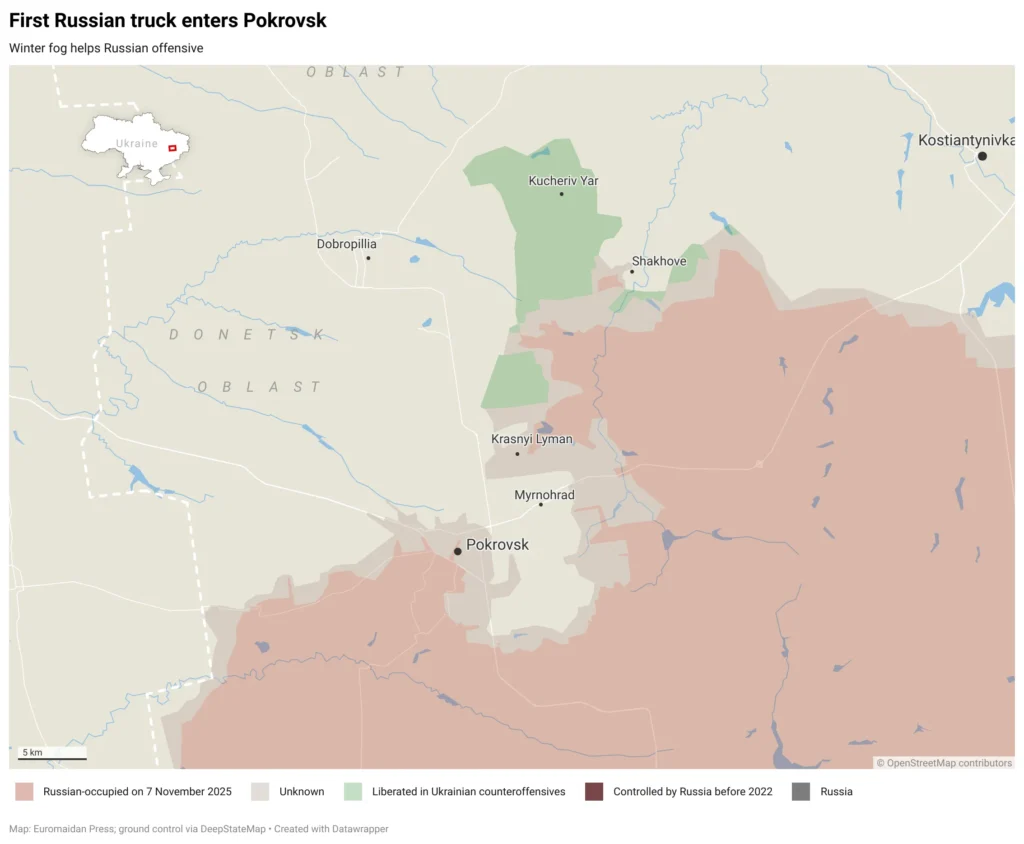
But even as more Russian infantry sneaked into Pokrovsk, Ukrainian forces in and around the city managed to defeat a fresh wave of Russian mechanized assaults. The long break in vehicular operations had helped the Kremlin stockpile thousands of tanks and other vehicles—and many of them have staged around Pokrovsk.
That changed in the past month or so as Russia's own creeping encirclement of Pokrovsk and neighboring Myrnohrad, and the growing number of Russian drones along this sector of the front, squeezed Ukrainian logistics. "Virtually every vehicle heading into the city comes under attack," Ukrainian philanthropist Serhii Sternenko reported.
Even as Ukrainian defenses stiffened north of Pokrovsk, the defenses in Pokrovsk frayed for a want of people, supplies, and heavy weapons ... but mostly people.
Given Ukraine's continuing struggles to recruit enough fresh troops, it was probably only a matter of time before a Russian vehicle ran the gauntlet and arrived in Pokrovsk.
That time has come. It was already overdue for the surviving Ukrainians to retreat from Pokrovsk. Now withdrawal is even more urgent. "Losing the city now is far less critical than preserving the force," Kofman wrote.
Why Ukrainian defenses are weakening in Pokrovsk:

Russian pockets found and erased. The 91st Separate Battalion, in cooperation with the Ukrainian Air Force Command, destroyed a shelter with the occupiers with scarce guided aviation bombs on the Pokrovsk direction.
According to Ukraine's 7th Air Assault Corps, over 200 Russian soldiers are currently stationed in Pokrovsk. They are constantly infiltrating the city. However, the entire grouping on this axis is estimated at 170,000 troops.
Russian President Vladimir Putin reportedly ordered the Russians to capture the city by 15 November in order to demonstrate to the US President Donald Trump administration that Ukraine must cede the country’s east to Russia. Russia has been attempting to seize Donetsk and Luhansk oblasts for 12 years.
Ukraine’s domestic production of guided aerial bombs is in the early stages of development. The Ukrainian Air Force currently uses Western-made weapons: GBU-39, GBU-62 of various calibers.
On the monitors of the battalion’s command center, they detected several Russian positions with concentrations of occupiers.
“The unit alone cannot completely eliminate them — guided aerial bombs are needed,” the 91st battalion explained.
Ukraine's 91st Separate Battalion showed tight, battle-tested teamwork with the Air Force on the Pokrovsk axis
— Euromaidan Press (@EuromaidanPress) November 7, 2025
Using their control-center screens, they spotted several Russian clusters and called in aviation bombs to wipe out shelter full of occupiers91st Separate Battalion pic.twitter.com/EGWK1YDahk
The battalion command decided to develop the operation in close coordination with aviation. In the released footage, you can see how the aviation bombs, also known as KABs, hit the target within minutes.
“The shelter with personnel was eliminated. Short. Precise. Effective,” the battalion reported.
Meanwhile, Artem Prybilnov, head of communications for the Ukrainian 155th Separate Mechanized Brigade named after Anna of Kyiv, told Radio Free Europe/Radio Liberty that Russia increased KAB strikes on the Pokrovsk agglomeration to a record number in recent days.
For several days, there were hundreds of KABs per day.
Russian KABs remain one of the key problems on the front for Ukrainian troops, as Moscow is producing thousands of them each year. Using the bombs, Russia erases frontline towns from the face of the earth and destroys Ukrainian positions.
Air defense against KABs in Ukraine is currently provided by experimental and partially implemented systems, but full protection from such strikes has not yet been achieved.
Prybilnov noted that when Ukrainian positions are detected, the Russians strike them with 15 FPV drones and "always drop guided aerial bombs." They also use artillery and mortars.
He also said that Ukrainian fighters in Pokrovsk “are not retreating; we are moving to reserve positions because the defensive lines were completely destroyed and are not recoverable.”
As of 7 November, Ukrainian defenders repelled 58 Russian assaults in Pokrovsk, according to the Ukrainian General Staff.
Nearly 1,200 civilians remain in the city. Evacuation from the community is practically impossible due to the security situation, reports Dmytro Petlin, head of the duty operations, communications, alert, and public information department of the Donetsk Regional Military Administration’s Civil Protection, according to a Ukrinform.
The Russians are killing all civilians in their path, and orders to do so have been intercepted from several sources.
Ukrainian press officer of the 425th Separate Assault Regiment “Skelia” with the callsign “Pysmennyk” or "Writer" says that the Russians are moving across Pokrovsk constantly, sometimes dressed as civilians, per Armiia TV.
No such group recently raised a Russian flag on the Pokrovsk City Council building. After verifying this information, it was decided to restore the Ukrainian flag. Assault groups were formed to carry out this task.
Follow Euromaidan Press on Google News! YOUR SUPPORT = OUR VOICEAccording to Ukraine's 7th Air Assault Corps, over 200 Russian soldiers are currently stationed in Pokrovsk. They are constantly infiltrating the city. However, the entire grouping on this axis is estimated at 170,000 troops.
Russian President Vladimir Putin reportedly ordered the Russians to capture the city by 15 November in order to demonstrate to the US President Donald Trump administration that Ukraine must cede the country’s east to Russia. Russia has been attempting to seize Donetsk and Luhansk oblasts for 12 years.
Russian KABs remain one of the key problems on the front for Ukrainian troops, as Moscow is producing thousands of them each year. Using the bombs, Russia erases frontline towns from the face of the earth and destroys Ukrainian positions.
Air defense against KABs in Ukraine is currently provided by experimental and partially implemented systems, but full protection from such strikes has not yet been achieved.

When a company from the Ukrainian 425th Assault Regiment raised a Ukrainian flag on the city council building near the center of Pokrovsk on or just before Wednesday, it may have looked like Ukrainian forces were counterattacking in the embattled city.
Nothing could be further from the truth. The survivors of Pokrovsk's Ukrainian garrison are, in fact, trying hard to escape the ruins of the once-thriving mining city. To give the survivors of the 68th Jaeger Brigade and 155th Mechanized Brigade a fighting chance to escape to the new Ukrainian line north of Pokrovsk, several elite—but very small—units have deployed into the city.
They include that company from the 425th Assault Regiment. Don't mistake the company's jaunt into the city center for a counteroffensive. It's actually the covering effort for a belated general retreat. After a year of hard fighting, the battle for Pokrovsk "is coming to an end," observer Thorkill noted.
The Russian Center Group of Forces suffered shocking casualties marching on Pokrovsk from the ruins of Avdiivka, 40 km to the southeast, starting in the spring of 2024. The Russian group bled for every meter it advanced, but thanks to its sheer size—its 100,000 or more troops outnumber the local Ukrainian forces five to one—it did advance.
Key tactical factors in Pokrovsk's fall:
Geolocation of soldiers from Ukraine's 425th Skala Assault Regiment raising the Ukrainian flag in the Pokrovsk City Council building.https://t.co/INOzlLhklxhttps://t.co/GcH3oixSOv pic.twitter.com/PokSGlOs36
— Rob Lee (@RALee85) November 5, 2025
By the new year, it was on Pokrovsk's outskirts. By this summer, Russian infantry had begun infiltrating Pokrovsk in growing numbers—taking advantage of wide gaps in Ukrainian defenses to dart into the city, hunker down in some basement and await reinforcement.
A Russian incursion north of Pokrovsk in August drew Ukrainian reserves away from the city. Renewed Russian mechanized assaults this fall—following a long pause in mech attacks that allowed the Kremlin to stockpile vehicles—kept up the pressure north of Pokrovsk.
"The geometry of the battle has long been unfavorable" for Ukraine, wrote Michael Kofman, an analyst with the Carnegie Endowment in Washington, D.C., citing "deteriorating conditions, lack of reserves and [low] manning levels of deployed units."

That geometry got worse last month. "The situation around Pokrovsk deteriorated over time as Russian forces kept infiltrating through the southern part of the city," Kofman noted. "Ukrainian positions grew increasingly thin. Worsening weather enabled Russian troops to get more men into the city in recent weeks."
Russian drone teams have followed the infiltrators into Pokrovsk. Now Russian drones range across Pokrovsk and the few roads into the city and neighboring Myrnohrad. There's still a 3-km gap between the westernmost and easternmost Russian elements north of Pokrovsk and Myrnohrad—a way out for the Ukrainian troops in both settlements.
But that gap is patrolled by explosive drones. And it's in danger of closing completely any day now, especially if bad weather covers a fresh Russian push.
To hold open the gap as long as possible, and allow the survivors of the 68th Jaeger Brigade and 155th Mechanized Brigade to retreat north, the Ukrainian command has deployed that company from the 425th Assault Regiment as well as a company from the 82nd Air Assault Brigade and three special operations units.
These elite troops, perhaps just a few hundred in number, are too few and too lightly equipped to push back the thousands of Russians winding their way into Pokrovsk. But operating from defensive positions on the northern edge of Pokrovsk, the newly deployed elite troops have succeeded in holding off the Russians for now.

The "shattered subunits" of the 68th Jaeger Brigade and 155th Mechanized Brigade seized the opportunity to escape starting on the night of 27 October, according to Thorkill. Many of the survivors "left the city on foot." Russian drones and aerial bombs rained down, killing some of the escapees. But others made it out.
There are still some Ukrainian troops in the chaotic center and southern quarters of Pokrovsk. "Trapped," In Thorkill's assessment. It's probably no coincidence that the 425th Assault Regiment recently appeared in the city center. There were probably Ukrainian troops in need of rescue in the area.
As Ukrainian troops look for ways out of Pokrovsk and Myrnohrad, the fates of both settlements are clear. The Russians will capture their ruins in the coming days or weeks.
The porous front line will then shift a few kilometers north into the fields and villages north of Pokrovsk. The battle for Donetsk Oblast will grind on, with the Russians having yet again traded tens of thousands of casualties for a Ukrainian city whose outnumbered defenders fought for longer than should be possible.
Timeline of Pokrovsk's deterioration:

Russia's elite Rubicon (also spelled Rubikon) drone group is strangling the Ukrainian troops in Pokrovsk and neighboring Myrnohrad. So the Ukrainian Main Intelligence Directorate, the HUR, is trying to strangle Rubicon—by striking at its operators in one of their rear bases.
But the Ukrainian effort is too little, too late.
A recent HUR drone raid on an alleged Rubicon base near Avdiivka, 40 km southeast of Pokrovsk, is a desperate effort to delay the likely inevitable outcome of the yearlong Russian siege of Pokrovsk and Myrnohrad in eastern Ukraine's Donetsk Oblast.
Ukraine's GUR says they struck the forward headquarters of the Russian Rubicon drone unit near Avdiivka. Rubicon is Russia's most technologically and tactically advanced drone unit and has played a critical role in their Pokrovsk offensive. pic.twitter.com/UVnNr5JyEE
— Preston Stewart (@prestonstew_) November 4, 2025
Potentially thousands of Ukrainians are still fighting in and just south of the settlements, but they're nearly cut off by a Russian force that outnumbers them five to one. The Russian armed forces "have intensified efforts to encircle the Pokrovsk–Myrnohrad agglomeration," the Conflict Intelligence Team noted.
"Currently, only about 3 km remain between the converging segments of the contested area north of Pokrovsk and southwest of Krasnyi Lyman—a narrow corridor through which Ukrainian troops could potentially exit the operational encirclement," CIT warned.

Disrupting one Russian drone group might buy the Ukrainians more time to escape Pokrovsk and Myrnohrad. But it's unlikely to save the settlements.
The HUR launched its attack drones at the Rubicon base under the cover of darkness on or before Tuesday. Footage from the long-range, first-person-view drones shows at least one of them slamming into a two-story building the HUR claimed housed Rubicon operators.
It's unclear how much damage the raid inflicted. And it probably doesn't matter very much. The real damage along the Pokrovsk-Myrnohrad axis is being inflicted by Rubicon teams flying short-range first-person-view drones whose operators are on the front line ... not behind it near Avdiivka.
Key facts about the Pokrovsk-Myrnohrad encirclement:
Rubicon is among the best Russian drone groups. It made its major combat debut in February when it deployed its FPV teams north of the Ukrainian-held salient around the town of Sudzha in western Russia's Kursk Oblast. The drones swiftly destroyed hundreds of Ukrainian trucks, cutting off the flow of supplies into Sudzha and compelling the Ukrainian troops to retreat.
The elite unit was created in mid-2024 under orders from Russian Defense Minister Andrei Belousov, combining drone development, operator training, and electronic warfare capabilities. It operates at least seven detachments of 130-150 personnel each, with projections to reach 5,000-6,000 specialists by fall 2025.
The Kremlin's attention then shifted south to Donetsk ... and Pokrovsk.
Sometime this summer or fall, the Russian Center Group of Forces—which had been steadily grinding toward Pokrovsk for more than a year—finally got close enough to the settlements for supporting FPV operators to fly their tiny drones directly over the two main supply routes threading into Pokrovsk and Myrnohrad.
All that we are seeing today in Pokrovsk and Myrnohrad happened mostly due to the unmanned (fpv) forces of the russians, who are blocking our logistics. The same crews that destroyed our logistics on the Kursk direction last winter and spring are still operating. Essentially, if…
— східний (@samotniyskhid) November 4, 2025
Some controlled by radio, others guided by signals traveling along jam-proof fiber-optic cables, the FPV drones made it extremely dangerous for any Ukrainian vehicle to travel along the roads during daytime. The proliferation of FPVs with thermal cameras meant nighttime was only slightly safer.
"All that we are seeing today in Pokrovsk and Myrnohrad happened mostly due to the unmanned FPV forces of the Russians, who are blocking our logistics," Ukrainian service member Skhidnyi wrote. "The same crews that destroyed our logistics on the Kursk direction last winter and spring are still operating."
There may be scores of Russian FPV teams along the porous front line around Pokrovsk. Realistically, the HUR can't hit them all.
Ukrainian forces previously struck Rubicon's command post in August 2025, destroying a large ammunition depot in Donetsk Oblast. While that operation temporarily disrupted the unit's operations, military experts warned the unit remains a systemic threat that requires a comprehensive counter-strategy beyond individual strikes.
Rubicon's drone capabilities:
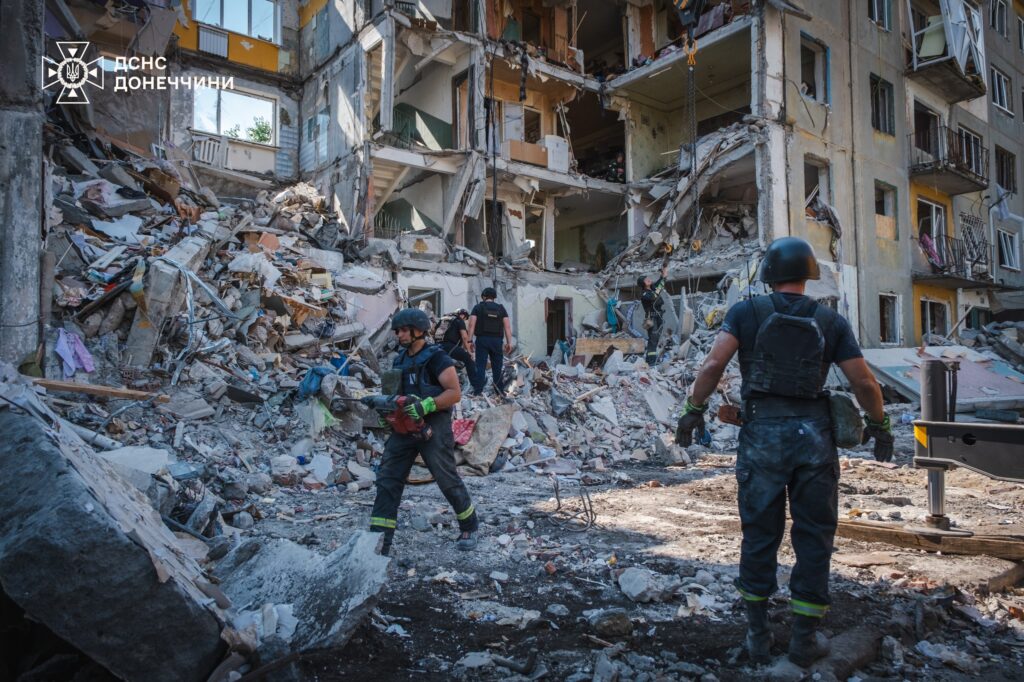
The gap between separate contingents of Russian troops advancing east and west of Myrnohrad is now just 3 km. With every passing day, it becomes much more difficult for the Ukrainian troops south of the closing Russian pincer to receive supplies through the gap—or retreat through it to the north.
Current situation in Myrnohrad: Russian pincer gap stands at just 3 km between advancing forces. Ukrainian defenders—parts of the 25th Air Assault and 38th Marine brigades—face an encirclement timeline measured in days, not weeks. One remaining corridor under heavy drone surveillance provides the only escape route.
The implication is clear, according to the pro-Ukraine Conflict Intelligence Team. "It is time for the [armed forces of Ukraine] to abandon Myrnohrad and the area south of it," CIT urged.
Myrnohrad, an industrial town with a pre-war population of around 40,000, lies just east of Pokrovsk, a mining city with a pre-war population of more than 100,000.
Current situation in Myrnohrad:
Pokrovsk and Myrnohrad anchor Ukrainian defenses in Donetsk Oblast. Capturing Pokrovsk would give the Russian Central Group of Forces a clearer shot at the twin cities of Kramatorsk and Sloviansk, 60 km to the north—major population centers that remain under Ukrainian control.

For more than a year, outnumbered Ukrainian forces have defended Pokrovsk and Myrnohrad. At tremendous cost in men and machines, the Russians ground toward the city, trading bodies and equipment for every meter of Ukrainian soil.
Initially rebuffed on the outskirts of Pokrovsk and Myrnohrad, the Russians pivoted—and began encircling the twin settlements instead of directly assaulting them.
In March, the Russian 132nd Motor Rifle Brigade discovered gaps in Ukrainian defenses northwest of Pokrovsk and quickly marched north toward the village of Dobropillia, which sits astride one of just two main supply routes into Pokrovsk and Myrnohrad.
The Russians lost the subsequent battle for the Dobropillia pocket, but only after the Ukrainian 1st Azov Corps—one of Ukraine's main formations then in reserve for emergencies—rushed toward the salient.
The Ukrainian counterattack prevented the supply lines from being overrun by Russian infantry, but couldn't prevent the best Russian first-person-view drones—flown by Rubicon and other elite groups—from striking Ukrainian vehicles speeding down the roads into Pokrovsk.
"Virtually every vehicle heading into the city comes under attack," Ukrainian philanthropist Serhii Sternenko warned. "It's impossible to quickly evacuate the wounded. It's impossible to deliver supplies and ammunition on time. The main losses aren't at the positions, but on the road."
Це жахливе відео, але його потрібно бачити.
— Serhii Sternenko ✙ (@sternenko) November 3, 2025
Це дорога у Покровськ. Під повним вогневим контролем ворога.
Що ховається за сухою фразою «повний вогневий контроль»?
Саме те, що на відео.
Практично кожна одиниця транспорту, що прямує у місто, зазнає атак. Неможливо швидко вивозити… pic.twitter.com/b0kZPOZUXT
Resuming mechanized attacks after a long pause, the Russians continued to close their pincer around Pokrovsk and Myrnohrad through October, slowly strangling their Ukrainian garrisons. Now it's too late to save either settlement. "Both towns are effectively lost and recapturing them is nearly impossible," CIT noted, "as AFU reserves were deployed to the neighboring front-line section to stabilize and eliminate the Dobropillia breakthrough."
Today, there are hundreds of Russian infiltrators inside Pokrovsk and more than 100,000 Russians in the wide front around the city.
Parts of just two Ukrainian brigades—the 25th Air Assault Brigade and the 38th Marine Brigade—remain in and around Myrnohrad. They should retreat first, followed by any troopers from the 155th Mechanized Brigade who remain in Pokrovsk.
The pincer is closing, but it's not impossible for the Ukrainians to escape. "Although we expect the gray zone to close soon, full encirclement and capture or killing of all soldiers trapped in the pocket cannot be anticipated," CIT explained. "In modern warfare, where Russian advances often involve small units, similar small Ukrainian groups may still be able to break out, despite the risks of drone strikes or firefights."

But the retreat will be dangerous. And the Ukrainians will have to escape on foot, leaving behind any heavy equipment that remains in Myrnohrad.
The order to quit Myrnohrad could have—and, according to some observers, should have—come much earlier. Ukrainian forces are preparing new defensive lines north of Pokrovsk. And with their advantage in drones as well as the natural advantages any defender enjoys over an attacker, the Ukrainians are increasingly adept at defending open terrain where approaching Russian troops have nowhere to hide.
Unlike in cities, where the attacking Russians have everywhere to hide.
Sternenko urged Ukrainian commanders to learn from Pokrovsk and Myrnohrad, and allow plenty of time for an orderly retreat once a city or town becomes indefensible.
But waiting too long to withdraw is becoming a tragic tradition in the Ukrainian armed forces. It happened in Bakhmut. It happened in Avdiivka. It happened in Sudzha.
"Every time, our forces withdrew at the last moment with heavy losses, abandoning property and equipment," Sternenko pointed out. "Not everyone could get out. Some remained in their positions forever."
"This is happening again right now."
Recent Ukrainian withdrawals:

Belgium, home to NATO's headquarters, has acknowledged the security problem to counter waves of drones spotted in many European states this fall. The country has admitted it is struggling to deal with the targets spying on a critical military base that hosts its advanced fighter jets, Business Insider reports.
Theo Francken, the Belgian defense minister, said on 2 November that the country detected at least three large drones flying high above the Kleine-Brogel air base in a single night.
The base, in northeastern Belgium, houses the country’s fleet of F-16 Fighting Falcons, and Brussels plans to station its new F-35 Lightning II aircraft there.
It is also believed that the US stores several dozen nuclear weapons at Kleine-Brogel as part of its nuclear deterrence strategy in Europe.
Francken said that a deployed drone jammer failed to neutralize the drones. He suggested that the failure might have been caused by issues with distance or by the jammer not being tuned to the correct radio frequency.
He added that a police helicopter and several vehicles were mobilized to pursue one of the drones, but they eventually lost track of it after following the system for several kilometers.
Francken said that “additional counter-drone air systems are urgently needed.”
Although he did not specify who was operating the drones, European leaders have repeatedly suggested that Russia is behind a series of recent similar incursions into NATO territory.
On 28 October, Ukrainian President Volodymyr Zelenskyy said that Russia employed oil tankers to launch and control drones targeting European nations. This way, the launch of drones may be invisible.
A series of incidents has pushed Europe to look for cost-effective ways to counter enemy drones, which are often much cheaper than the interceptors NATO has traditionally relied on for aerial threats.
Some NATO allies, including Denmark and Poland, have sought to strengthen their air defenses with help from Ukraine, which frequently faces hundreds of Russian drones in a single night.
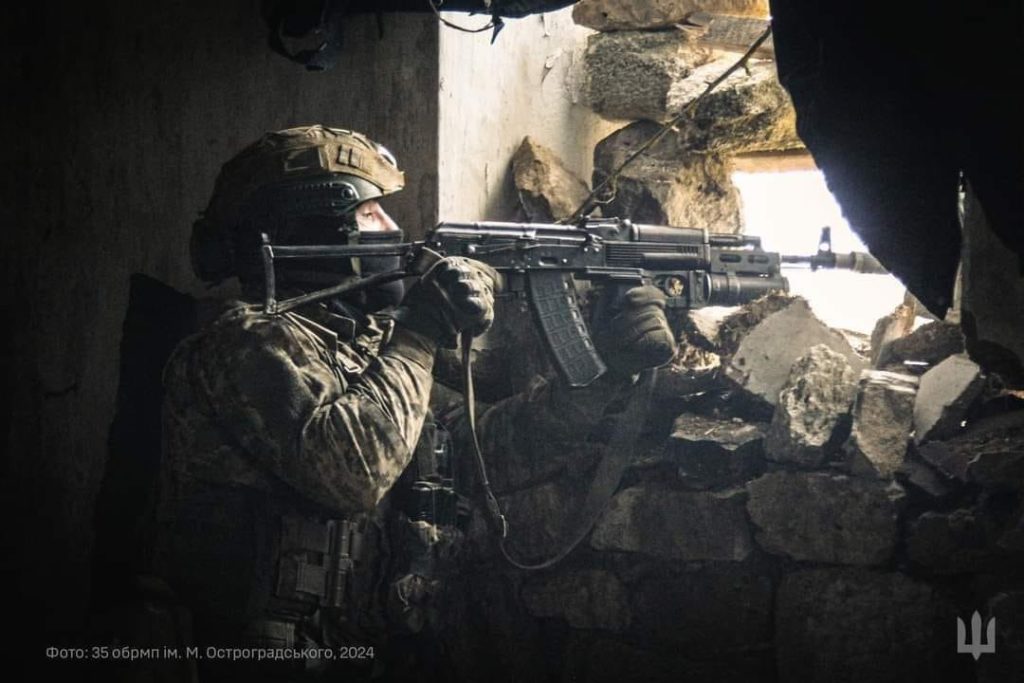
Ukrainian troops are dangerously close to being surrounded in the 30-square-kilometer pocket stretching from Pokrovsk east to Myrnohrad. The open end of the pocket, the only escape route for some or all of no fewer than three Ukrainian brigades—the 25th Air Assault Brigade, the 38th Marine Brigade and the 155th Mechanized Brigade—is barely 10 km across.
Commanders have yet to order the garrisons in Pokrovsk and Myrnohrad to withdraw north to the next line of Ukrainian defenses.
In any event, it's probably too late for a safe and orderly retreat. Russian drones and artillery can range across the only roads and footpaths out of the Pokrovsk-Myrnohrad pocket. If there's any reason to hope for anything short of a catastrophic withdrawal, it's that the front line in Ukraine isn't really a line anymore—it's a porous zone of contested control.
Updated map showing further Russian advances in Pokrovsk, east of Huliaipole, and south of Volodymyrivka. Ukrainian forces advanced east of Nove Shakhove. https://t.co/JGmIEhpXnK pic.twitter.com/7rsT5YlU1O
— Rob Lee (@RALee85) October 30, 2025
Maybe all those Ukrainian paratroopers, marines, and mechanized troops can slip out of the pocket the same way Russian troops have been slipping into it—on foot in small groups, at night. But it's risky. And the retreating Ukrainians may leave behind a lot of heavy equipment.
Serhii Sternenko—founder of the Sternenko Fund, which equips Ukrainian forces with drones—surely spoke for many Ukrainians when he voiced his frustration.
Citing chaotic and costly Ukrainian retreats from Avdiivka, Vuhledar, and Sudzha, he asked how yet another Ukrainian force could find itself "in a fire sack."
"Every time, our forces withdrew at the last moment with heavy losses, abandoning property and equipment," Sternenko wrote. "Not everyone could get out. Some remained in their positions forever. This is happening again right now."
How this happened is clear to see. A powerful Russian force with more than 100,000 troops and hundreds of armored vehicles has been marching on Pokrovsk for more than a year since capturing the ruins of Avdiivka, 40 km to the southeast.
Follow Euromaidan Press on Google News! YOUR SUPPORT = OUR VOICEThe Ukrainian armed forces bled the Russians for every kilometer they advanced, but the main defensive line was anchored by Pokrovsk itself. That was consistent with Ukraine's urban defense strategy. For nearly four years since Russia widened its war on Ukraine, Ukrainian commanders have fortified cities at the expense of the countryside.
That used to make sense. Built-up urban areas can hide and protect infantry fighting on the defensive, helping them repel enemy assaults.
The problem, in 2025, is that Ukraine is desperately short of trained infantry.
"To put it as bluntly as possible: Ukraine has fallen short by at least 10,000 recruits per month over the past two years," Ukraine Control Map explained.
"We don't lack the will to fight," wrote Ryan O'Leary, the former commander of the now-shuttered Chosen Company, a volunteer unit that fought in Ukraine. "We lack the infantry to hold the ground so we can continue fighting."
Ukraine compensates with a large force of tiny explosive drones. But the drones are most effective on open terrain where there's nowhere for their prey to hide.
They're least effective over cities, where their prey has everywhere to hide. If Russian troops can slip through the many wide gaps in Ukrainian defenses, they can accumulate in small but growing numbers inside a city like Pokrovsk.

There, the "overwhelming number of Russian soldiers and the possibility to hide easily from drones inside cities” make a drone-based urban defense “more difficult,” French analyst Clément Molin explained. The drones can't find or hit all the Russians in their basement hideouts. And there are too few Ukrainian infantry to clear out the Russian infiltrators the old-fashioned way: with direct close combat.
Since arriving at the gates of Pokrovsk and nearby Myrnohrad late last year, the Russians have been slowly but steadily creeping into both cities in small groups. Today, there are around 250 Russian infantry inside Pokrovsk. That might not seem like a lot, but it's enough to create a lodgement for follow-on forces.
Meanwhile, Russian assaults northeast of Myrnohrad and northwest of Pokrovsk have partially closed a pincer around the twin cities, nearly bottling up the Ukrainians in the settlements. "The enemy cut off our logistics," Sternenko pointed out. Aerial resupply via drone is still possible, but drone resupply can't fully replace ground resupply, which is much more efficient.
There may have been an opportunity for Ukrainian troops to safely leave Pokrovsk and Myrnohrad. But it was weeks ago. And it required Ukrainian commanders to understand that their most abundant forces—small drones—work best over open terrain.
The old urban defense model may be obsolete.

A Russian official charged by the International Criminal Court (ICC) with the unlawful deportation of children openly described taking a Ukrainian teenager from Mariupol and "re-educating" him until he abandoned his Ukrainian identity.
The Institute for the Study of War (ISW) assessed that such actions may constitute genocide under the Convention on the Prevention and Punishment of the Crime of Genocide.
Maria Lvova-Belova, Russia's Commissioner for Children's Rights, gave the account in 6 October interview. She said she met 15-year-old Pylyp while "traveling through basements and collecting children who were under fire" in occupied Mariupol after Russia's full-scale invasion began in 2022.
Pylyp had lost his mother at age 10 and was living with a foster family. According to Lvova-Belova, when fighting started, that family gave him his documents and left him alone. He found Russian soldiers and asked for safety.

Lvova-Belova claims Pylyp agreed to live with her family. But she said he arrived traumatized from the shelling and began causing problems in her household. The issue, according to her account: Pylyp maintained what she called "a special attitude toward Russia"—negativity "which had long been cultivated in children in Mariupol schools."
In her telling, Pylyp told her he loved her but hated everything about Moscow and Russia. He didn't want to live in Russia. He loved Ukraine and read pro-Ukrainian websites. Lvova-Belova said she spent nights talking with him, telling him he needed to change his attitude now that he was in Russia.
Pylyp also sang Ukrainian songs, which Lvova-Belova claims he later admitted was an attempt to make her return him faster, to stop hoping his life could change.
Eventually, she claims, "changes in consciousness began" in the boy. Now he doesn't even want to return to Mariupol when he visits.
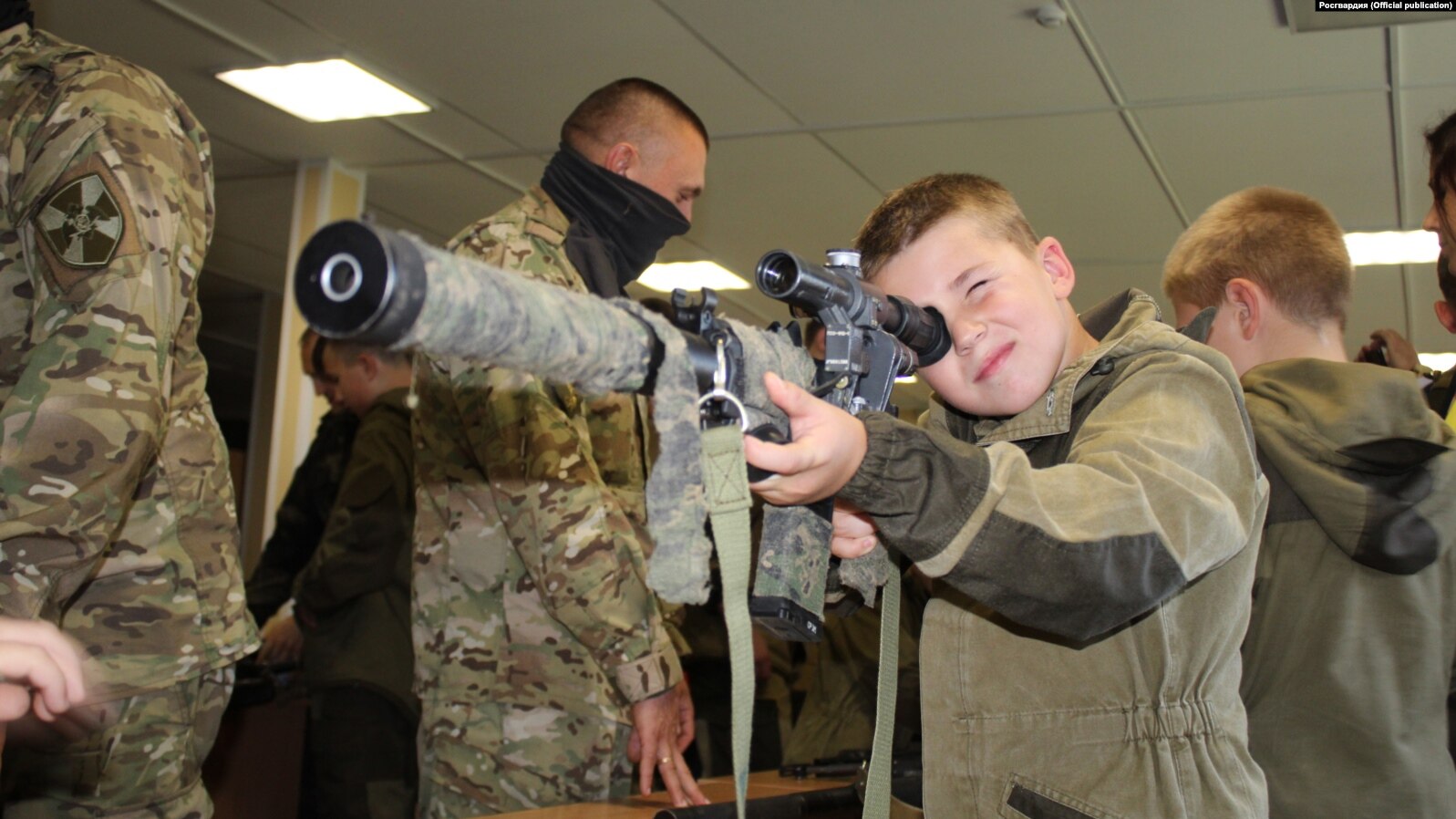
This incident represents one example, that the ISW has documented, of how Russia works to eliminate Ukrainian identity and colonize both the land and minds of people in occupied territories.
Russia frames its relationship with Ukraine through claims of historic and cultural ties, with President Putin publicly denying Ukraine's status as a fully independent nation and describing Russians and Ukrainians as "one people."
Russia's goal extends beyond merely seizing land. The re-education of children like Pylyp, the militarization of Ukrainian youth on occupied territories, and the suppression of Ukrainian language and culture serve a long-term purpose: creating a population that identifies as Russian, accepts Russian narratives, and can be potentially mobilized as soldiers and supporters for further expansion.
The patterns reveal a coordinated approach spanning education and military indoctrination of children, population replacement, repression, and information control.
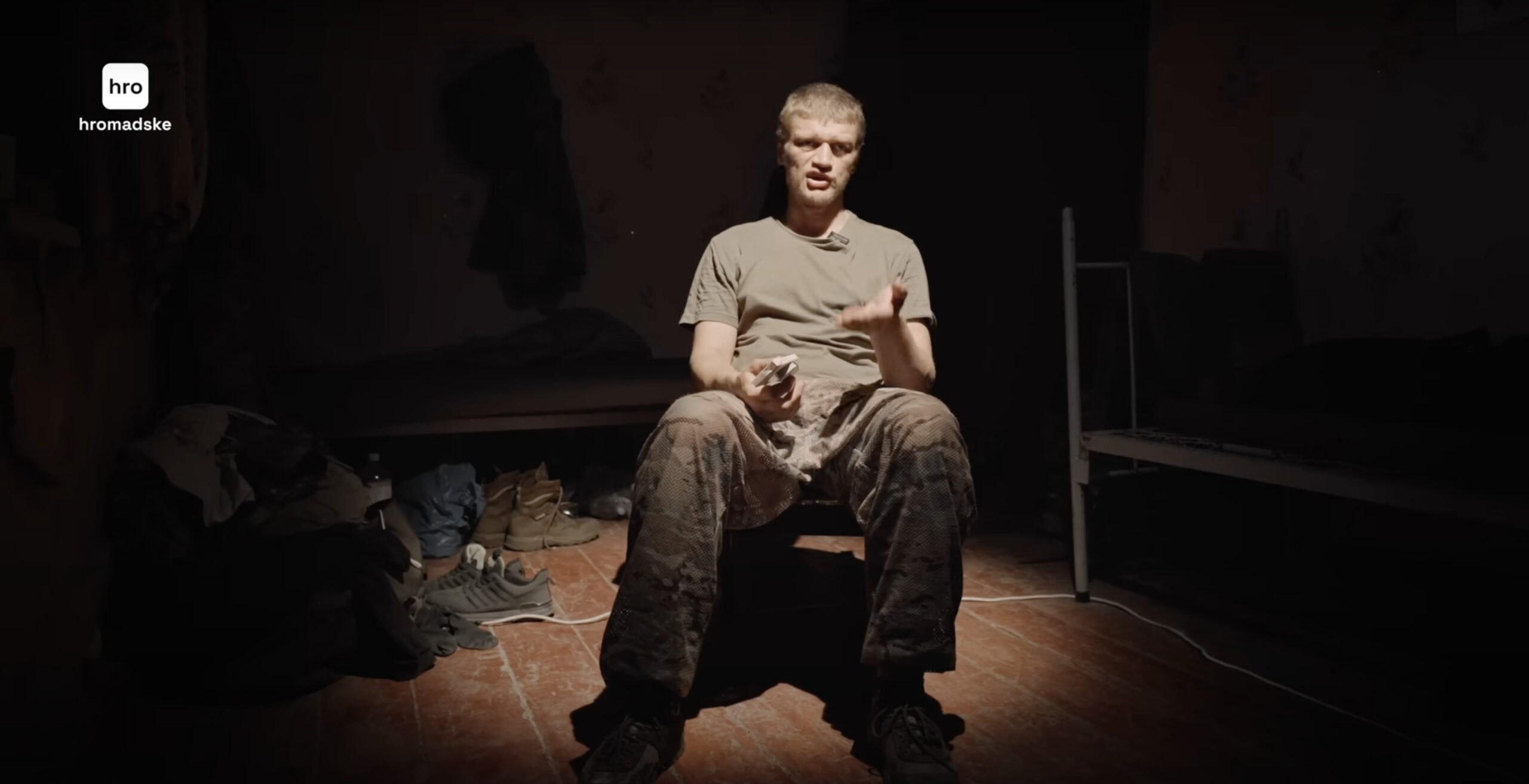
Families living under occupation face a basic dilemma: children need to go to school. Many of these children studied their entire lives in Ukrainian, learned Ukrainian history and read Ukrainian literature. But Russian occupation authorities now demand they switch languages, abandon their curriculum, and attend Russian-controlled schools.
Those who refuse face escalating consequences. Pavel Filipchuk, occupation head of Kakhovka district in occupied Kherson Oblast, made this explicit in late September. His administration identified over 200 children not attending Russian-controlled schools. Some families were keeping their children enrolled in Ukrainian online schools instead.
Filipchuk dismissed Ukrainian education, calling it "a child with a poor education from unclear teachers—a tragedy."
He announced that authorities would start with fines and escalate to deprivation of parental rights and home raids for continued non-compliance.

Ukrainian Commissioner for Children's Rights and Rehabilitation Daria Herasymchuk added that Russian occupation officials punish children and parents for studying Ukrainian language and literature in occupied areas, with methods including beatings, isolation of children, and forced administration of psychotropic drugs.
While Russian authorities claim students retain the "option" to study Ukrainian language, they have simultaneously taken steps to substantially limit access to Ukrainian language instruction and disincentivize participation in what limited courses remain available.
In June, the Russian Ministry of Education published a draft order detailing plans to effectively ban Ukrainian-language education in occupied Ukraine starting 1 September 2025. The escalating punitive measures against families who choose Ukrainian education reveal the false nature of any claimed "educational choice," ISW analysts conclude.

Once children enter Russian-controlled schools, they face another form of control: militarization programs designed to train them as potential future soldiers and instill hatred of Ukraine and the West.
In October, Crimea occupation head Sergei Aksyonov announced the launch of the "Heroes of Russia-Pride of Crimea" project at a kindergarten and secondary school in occupied Simferopol.
The project installs permanent exhibitions in schools featuring photographs of Soviet World War II veterans and Russian soldiers from the current war in Ukraine. Each photo includes a QR code that students can scan to read extended biographies of what Aksyonov calls "heroes."
Aksyonov framed the project as teaching children "proper" role models, saying these are people "who left their bright mark in the struggle for our great Motherland, who proved not by word but by deed that they are true patriots of their country."
"I believe that such people should serve as an example for the younger generation. After all, there is nothing more honorable, nothing more valuable, than serving one's Motherland," Aksyonov wrote.

The project will spread to all schools in occupied Crimea as an important step in the "patriotic development" of children and to instill "personal responsibility" for Russia's destiny, according to the official.
Accompanying images showed young children in cadet-style uniforms standing next to uniformed Russian servicemen and posing with donation boxes marked with Z symbols and the Russian military slogan "We don't abandon our own."



Russian soldiers actively fighting in Donetsk Oblast are also training Ukrainian teenagers. During a three-day course in October, combat troops taught youth from occupied Donetsk how to handle military equipment, navigate battlefields, provide tactical medical care, operate in combat groups, and fly quadcopters.
These aren't retired veterans offering generic patriotic talks - they're active servicemembers passing combat experience directly to Ukrainian children.
"The purpose of such training activities is clearly to prepare Ukrainian youth for future service in the Russian military, including by disseminating to them critical lessons on the realities of contemporary warfighting," the ISW states.

While children are indoctrinated through schools and military training camps, adults who resist Russian control are prosecuted as "terrorists" and "extremists."
Russian authorities use fabricated criminal charges to silence opposition and make any expression of Ukrainian identity dangerous.
Russia is working to expand those definitions even further. In October, Zaporizhzhia's occupation administration commissioned a $68,000 study on "Ukrainian nationalist ideology" to get Moscow to officially classify it as "extremism."
Residents already face charges of terrorism, extremism, and high treason for pro-Ukrainian sentiment, which carry lengthy prison sentences. The study, however, would grant law enforcement even broader authority to criminally prosecute people of occupied areas.
This legal framework targets not only ethnic Ukrainians but anyone who doesn't conform to Russian identity. Crimean Tatars, the peninsula's indigenous Muslim population, face particularly harsh persecution.
Crimean Tatars largely opposed Russia's 2014 illegal annexation of Crimea and continue to advocate for the peninsula's return to Ukraine. Moscow views them as disloyal and uses their suppression to silence dissent and demonstrate control.
In October, the Russian Federal Security Service intensified this crackdown by targeting four Crimean Tatar women. The FSB conducted searches in four homes in occupied Crimea, detained Esma Nimetullayeva, Nasiba Saidova, Elviza Alieva, and Fevziye Osmanova, and transported them to Simferopol on charges of "organizing and participating in the activities of a terrorist organization."
Human rights activists maintained the women's innocence, stating the arrests are part of Russia's systematic campaign against the Crimean Tatar community. The FSB has historically used fabricated extremism charges to persecute the minority group and consolidate control.

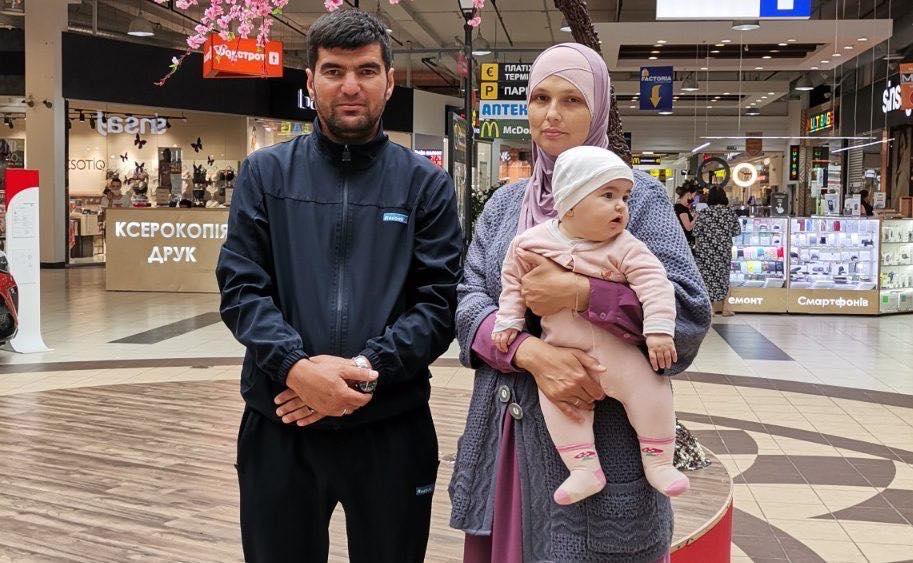



Suppressing existing Ukrainian identity on occupied territories is only half of Russia's demographic strategy. The other half involves replacing the population itself.
Russia's full-scale invasion displaced approximately 2.9 million people from areas now under occupation and killed tens of thousands more, according to ISW. To legitimize its occupation, Russian authorities are implementing policies designed to repopulate these territories.
Russia's migration policy concept for 2026-2030, signed by President Putin in October, includes provisions to "create conditions for the return" of residents who fled occupied Donetsk, Luhansk, Kherson, and Zaporizhzhia oblasts. While the concept doesn't specify implementation methods, it likely signals financial or legal incentives aimed at convincing Ukrainian refugees to return to occupied areas.
Russia is also repopulating occupied territories by stealing Ukrainian property and giving it to Russian settlers.

The theft operates through a bureaucratic facade. In July 2022, Russian authorities invalidated all real estate documents issued by Ukrainian authorities between 2014 and 2022, stripping property rights from anyone who had purchased, inherited, or transferred property during eight years of Ukrainian control.
They compiled lists of apartments classified as "ownerless" - a category that includes property whose owners died, fled the war, or are Ukrainian citizens living abroad.

Property owners have 30 days to appear in person and prove ownership. But returning requires traveling through Moscow, where Russian security services interrogate arrivals, examine social media for pro-Ukrainian content, and demand Russian passports. Any pro-Ukrainian activity risks jail, while the journey is also costly for people who have already lost their homes and jobs in the war.
Russian authorities stopped accepting Ukrainian passports in October 2022 and rejected power of attorney arrangements in April 2025, demanding only personal presence. The system is designed to prevent rightful owners from reclaiming their homes.
Russia then offers this seized property to Russians willing to relocate. A new draft law proposes allocating the "ownerless" apartments to government officials, military personnel, doctors, and teachers from other Russian regions as incentives.
Meanwhile, many Mariupol residents who survived a devastating three-month siege in the city are left homeless or moved to old dormitories. They protest to occupation officials demanding the return of their homes, but their appeals go nowhere.

Russia's control over minds extends beyond school curricula to what residents can watch and read at home. While children are taught Russian narratives in classrooms, adults—especially older people who rely on television for news—face similarly restricted information.
Russian occupation officials provided updates in October on the installation of Russkiy Mir [Russian World] satellite dishes throughout occupied Ukraine.
The Kherson Oblast occupation administration claimed it installed 20,000 Russkiy Mir satellite kits in total, while Zaporizhzhia Oblast occupation head Yevgeny Balitsky reported that 5,000 residents installed kits in the past month.
"This is 20,000 homes where the Russian language sounds, where people feel the support and presence of the country. For us, this is proof that Kherson Oblast is confidently moving toward full integration of the region into the unified digital space of the state," noted Roman Grigoriev, deputy minister of digital development and mass communications of the region.

These dishes transmit only Russian national and local channels, blocking access to Ukrainian or international media.
The Ukrainian Resistance Center warned that Russian occupation officials use the installation process to collect personal information on residents by registering addresses and personal details during installation.

The enforcement of Russian narratives and the erasure of Ukrainian identity operates at every level—from high-ranking Kremlin officials like Maria Lvova-Belova, who openly described "re-educating" Ukrainian teenager from Mariupol, to local occupation administrations threatening parents who refuse Russian schools.
It encompasses all areas of life from children's education to property seizure and control over what information residents have access to. Opposition to Russian control risks persecution and jail, with any dissent carefully monitored.
Russia keeps pushing to occupy more Ukrainian territory despite heavy losses and minimal gains. Ukrainian defenders have held the line for years. Wherever Russia establishes control, it imposes its rules, history, language, and traditions—suppressing the Ukrainian identity that existed before. The battle for Ukraine's sovereignty persists.
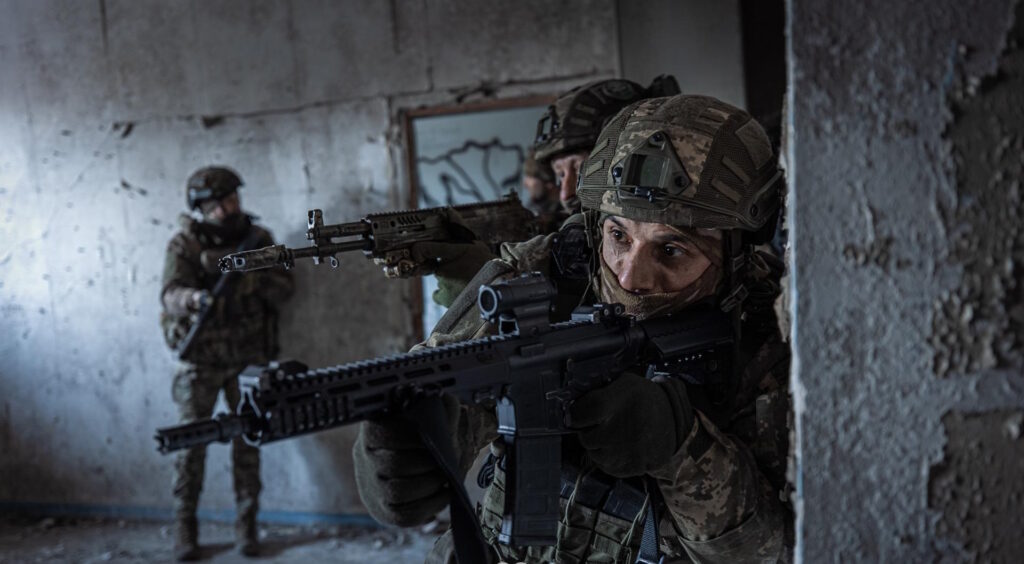
North of Pokrovsk, Ukraine is winning. South of Pokrovsk, Russia is winning.
Pokrovsk itself is likely lost—but that may matter less than the terrain around it. Open ground with clear sightlines and dense obstacles has proven easier to defend than sprawling cities, where Russian infiltrators exploit blind spots and gaps between Ukrainian positions.
The fall of the former mining city would open the road to Kramatorsk and Sloviansk—the last major Ukrainian strongholds in Donetsk Oblast. But Ukraine's counterattacks north of the city could establish a new defensive line against the Russian Center Grouping of Forces—perhaps 150,000 strong— in open terrain where Russian mechanized assaults have already failed repeatedly.
Capturing Pokrovsk has been the Russian command's top priority for a year now. Defending it has been the Ukrainian command's top priority. But the Ukrainians always had too few troops for the task.
Now there are hundreds of Russian infiltrators in the city center—and the supply lines to the embattled Ukrainian garrison are fraying.
"The fall of Pokrovsk appears inevitable," the pro-Ukraine Conflict Intelligence Team warned.
But Ukrainian victories north of the city should temper any dooming. Pokrovsk is likely to fall, and soon. But Ukrainian brigades may be able to establish a new and stronger defensive line north of the city.
That's because cities are no longer the key defensive positions they used to be.
"It has become easier to defend fields or villages than large cities," French analyst Clément Molin pointed out. "Fewer soldiers are needed, the Russian infantry is quickly spotted, and the increasingly numerous obstacles (ditches, barbed wire) sometimes prevent progress."
Russian
— Clément Molin (@clement_molin) October 25, 2025soldiers have been sighted in the center of Pokrovsk, a strategic city in the east of Ukraine
After months of infiltration, russian troops are threatening to capture two of the last 7 big cities of Donbas, while they started entering a 3rd one.THREAD
1/21
pic.twitter.com/rPbUgSzCcg
That's not mere theory. A clutch of Ukrainian brigades overseen by the 1st Azov Corps isn't just holding the line in the fields just north of Pokrovsk—they're actively counterattacking in several directions, steadily chipping away at a salient Russian infiltrators carved in the Ukrainian line back in August.
In and around the village of Shakhove on the eastern edge of the collapsing salient, the Ukrainian 33rd and 93rd Mechanized Brigades and 95th Air Assault Brigade have repulsed several Russian mechanized assaults in recent weeks.
Despite occasionally bad weather that can interfere with aerial surveillance, drones have detected the approaching Russian vehicles—and mines, drones, and artillery have blasted them from above and below.
A Russian mech assault on Saturday may have been the biggest of the current campaign. "It’s hard to count how many [vehicles] were used because of the bad weather conditions (fog)," Ukrainian drone operator Kriegsforscher wrote. "But we are sure that [there were] dozens."
When the Ukrainians got done with them, 16 vehicles lay immobilized and burning, Kriegsforscher reported.
Shakhove holds. Meanwhile, a few kilometers to the west, on the other side of the collapsing salient, Ukrainian forces are on the move. In the past week, they've liberated several villages, including Kucheriv Yar.

That won't save Porkrovsk, however. Ukrainian positions are too few and too widely spread to block all Russian attempts to infiltrate the city from the south.
The Russians have "used inter-positional space and infiltrated small infantry groups," gradually concentrating around 200 soldiers in Pokrovsk, according to the Ukrainian general staff.
"In effect, this statement acknowledges a critical shortage of Ukrainian manpower, which prevents the establishment of a continuous defensive line," CIT observed. "The gaps between Ukrainian strongpoints—the so-called inter-positional space—are precisely the areas through which Russian troops are advancing."
The end is coming for Pokrovsk. How soon is unclear.
"I believe the Pokrovsk battle is not over," Molin wrote. "It could last additional months. Everything will depend on what the leadership will do. Leave the city or fight for it."
Fighting for it could endanger the last few troops in the garrison, who may have to beat a hasty retreat as urban positions finally—and suddenly—become untenable. An orderly retreat could reposition Ukraine's precious manpower behind a new defensive along the open ground north of Pokrovsk.
Open ground that has proved to be a killing field for attacking Russians.
Follow Euromaidan Press on Google News! YOUR SUPPORT = OUR VOICE
The war has reached orbit. Europe must prepare its own space capabilities to defend itself, as Russia is developing laser weapons that could be deployed from space, European Commissioner for Defense and Space Andrius Kubilius, according to the European Commission.
Focus reported that in 2024, Russia claimed to have developed the Peresvet laser weapon system. This system can blind reconnaissance satellites in orbit to shield strategically important military facilities. Peresvet can cover an area with a diameter from 130 kilometers to 1,500 kilometers.
“The defense of space – and using space for defense is only becoming more urgent, because we are already under attack - also in Space," Kubilius stressed.
Kubilius emphasized that space is now a central element of Europe’s defense readiness.
"We need to be ready before 2030. Because Putin will be ready to test NATO Article 5. And without space, there will be no defence readiness,” he claimed.
The Commissioner said that satellites play a decisive role on the battlefield: in Ukraine, they help coordinate defense, communications, and drones, while Russian satellites guide bombs and missiles.
“Russia is developing powerful laser weapons that can permanently blind satellites. German satellites are being shadowed by Russian spy satellites, that could damage or destroy them,” Kubilius warned.
He explained that the EU’s new defense readiness roadmap envisions the creation of a European Space Defense Shield, to be launched next summer.
The plan also includes the development of in-orbit servicing, refueling, and repair operations for satellites, as well as the GOVSATCOM program — secure, military-grade satellite communications, which will be operational by the end of the year.
Kubilius said that in modern warfare, the European Union needs three things:
At the same time, the IRIS² satellite is being deployed to provide global, secure connectivity for Europe.
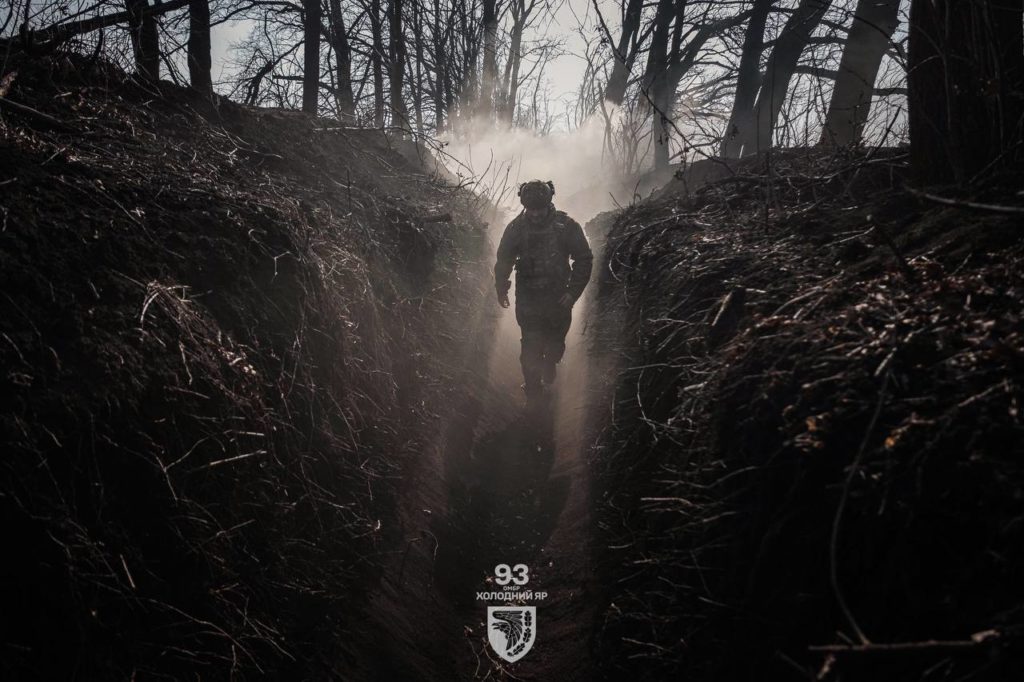
Under the cover of rain and clouds, no fewer than 29 Russian vehicles attacked Ukrainian positions northeast of the fortress city of Pokrovsk on Monday morning.
A clutch of Ukrainian brigades, including the 33rd and 93rd Mechanized Brigades, assisted by the 1st Azov Corps and the Unmanned Systems Forces, knocked out more than half of the vehicles with mines, drones, and artillery, and scattered the infantry who managed to dismount.
Losing half of a battalion-size assault group would be catastrophic for any other military. For the Russian military, it may actually represent a victory of sorts. It's possible enough infantry survived the assault to find covered positions and create a lodgement for eventual reinforcements.
If those reinforcements arrive in time, the Russians may be able to consolidate their new positions and create opportunities for future advances. "The levels of success from this attack will become clearer in the coming days," AMK Mapping noted.
Today, More:
— imi (m) (@moklasen) October 27, 2025
RU marines attack on Volodymyrivka today
33rd Mech workinghttps://t.co/U9aRCizsC2 https://t.co/KX914ftp3o pic.twitter.com/91J04fPpBo
The Monday assault, apparently involved some of the five Russian marine brigades and regiments that rushed toward Pokrovsk this summer, was "one of the most massive in recent times," the 1st Azov Corps reported.
The assault targeted Ukrainian positions northeast of Pokrovsk, where the Russians are struggling to hold onto a salient they carved out of Ukrainian lines in August. That salient, bending northwest toward the village of Dobropillia, is—or was, until recent Ukrainian counterattacks—Russia's best chance to encircle Pokrovsk from the north.
If—or when—Pokrovsk falls, the Russian Center Grouping of Forces will have a clearer path toward Kramatorsk and Sloviansk, the last major free cities in Donetsk Oblast.
Notably, according to the 1st Azov Corps, there was an unusually large number of up-armored "turtle tanks" among the 29 Russian vehicles that rolled out on Monday.
Tanks often lead Russian mechanized assaults, absorbing first-person-view drones with their add-on armor, clearing mines with their front-mounted rollers, and firing their cannons to suppress Ukrainian troops.

"The enemy tried to complicate the actions of the defense forces of Ukraine by advancing the equipment in small groups—four to five units—along different routes and at different times," the 1st Azov Corps stated. "The invaders also counted on adverse weather conditions, which would complicate the work of drones. Despite this, their plan was thwarted."
Fifteen of the 29 vehicles were immobilized, according to the 1st Azov Corps.
But perhaps thanks to the large proportion of tanks in the assault, 14 vehicles weren't immobilized—and may have dropped off their infantry passengers in new positions.
It's possible the tanks ate so many drones that there weren't enough drones left over to hit the other armored vehicles trailing behind the tanks, as well as the infantry they landed.
"The clearing of the enemy infantry landing sites continues," the 1st Azov Corps reported.
But if Ukrainian drones and counter-assaults can't clear out these infantry, it could become a problem for the Ukrainian defense north of Pokrovsk.
Experts warned something like this could happen.
“For those mocking armored vehicles and specially turtle tanks and thinking drones are a wunderwaffe that have rendered armor obsolete, take a look at the sheer amount of FPVs that are required to destroy a well-up-armored tank,” analyst Jompy wrote.
There are recent examples of Russian turtle tanks shrugging off dozens of drones before succumbing.
“It’s not about how many dollars a tank costs versus a drone,” Jompy added. “It’s about how many targets drone-intensive defenses can take out before being overwhelmed.”
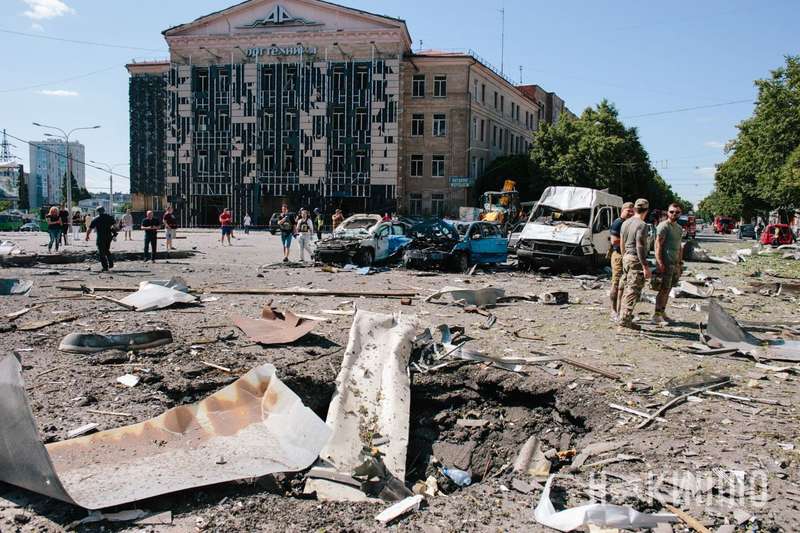
The Russians have begun using guided aviation bombs, also known as KABs, with rocket engines to strike Ukraine, but air defense systems are capable of shooting them down. Such bombs have already been recorded in the skies over Odesa, Mykolaiv, and Poltava oblasts, Suspilne reports.
A few days ago, the first strikes with these new rocket‑propelled KABs were recorded during the full‑scale war, with a range of 140 km. Russia is modifying the bombs, and there is a chance they could reach 200 km in the near future and even strike the capital, Kyiv.
Yurii Ihnat, head of communications for the Air Force of the Armed Forces of Ukraine, says that the Russians are using the new KAB modifications selectively, primarily to test the effectiveness of Ukraine’s defenses.
“This is the bomb released from an Su‑34: by flight parameters, it resembles a cruise missile, so it can be intercepted by air defense systems,” Ihnat explains.
He confirmed that Air Command South shot down two such KABs. Another fell in open terrain without consequences. Specialists are already determining the type of munition.
On 26 October, Russia launched a guided aerial bomb of a new modification toward Kryvyi Rih in Dnipropetrovsk Oblast.
Its debris damaged an industrial enterprise. Rescuers were deployed to the impact site to extinguish a fire. One person was injured in the city. The day before, the Russians struck Kamianske in Dnipropetrovsk Oblast for the first time with rocket‑powered aerial bombs of the UMPB‑5/Grom‑E type.
Vadym Kushnikov, an analyst for the portal “Militarnyi,” said on air that, given the Kyiv Oblast's proximity to the Russian border, some objects there could fall into the risk zone and be within reach of these new aerial munitions, per 24 Channel.
“As for the city of Kyiv, the distances are a little greater there, and accordingly, the chances of effective and successful use are significantly lower,” he stressed.
On 24 October, Ukraine’s Ministry of Defense reported that the NATO‑Ukraine Joint Analysis, Training and Education Center and NATO Allied Command Transformation conducted the next phase of tests of an innovative solution to counter guided aviation bombs.
During tests at a French range, developer teams evaluated a comprehensive technical solution under adverse weather conditions — radar, AI‑based software, and a drone interceptor.
The statement notes that a radar equipped with an advanced sensor suite detected, tracked, and engaged a simulated “hostile” target. Then, using AI software, the drone interceptor followed a pre‑computed trajectory to engage the target.
“The development has progressed from concept to prototypes of various levels of technological implementation and is intended to protect Ukrainian soldiers and civilians from one of the most destructive threats of modern warfare,” the statement said.
The project to counter Russian guided aviation bombs began in March 2025 with the 15th NATO innovation contest hosted at the NATO center.
Ukrainian specialists are directly participating in the tests and providing expert assessments, allowing the solution to be adapted to the realities of the modern battlefield.
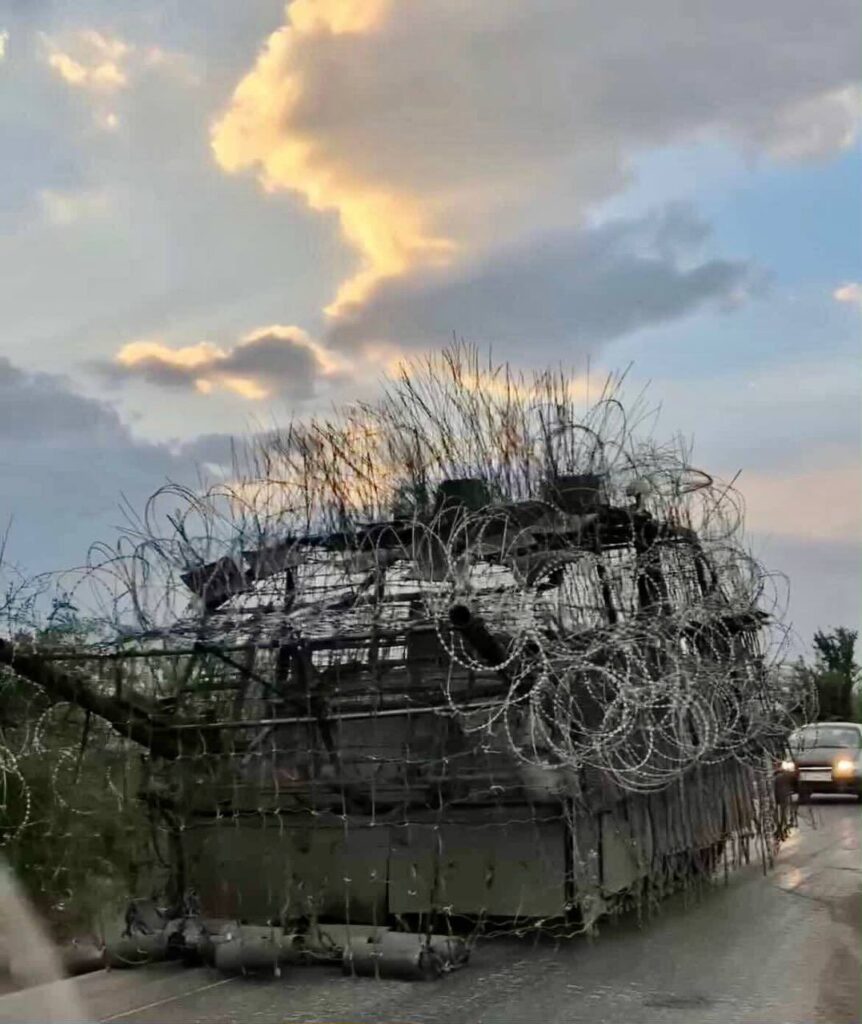
The Kremlin spent much of this year to stockpiling and adding protection to tanks, infantry fighting vehicles and other armor. And then, in early October, these vehicles attacked.
First, they attacked in the east around Pokrovsk and in the south around Mala Tokmachka. Then, on Thursday, they rolled out along a third front—near Siversk in eastern Ukraine's Donetsk Oblast.
It was a costly failure. But the next mechanized assault on Siversk might work.
Russian regiments and brigades east of Siversk, possibly including the 6th and 7th Motor Rifle Regiments, mustered a large for the daytime attack, including: a tank, three IFVs, three all-terrain vehicles and around 20 motorcycles.
russian mech and bike attack near siversk today
— imi (m) (@moklasen) October 23, 2025
UA 81st and 54th brigadeshttps://t.co/9wymRjfE4p pic.twitter.com/WvLHLNqJNT
The up-armored "turtle tank," wrapped in a metal shell of add-on anti-drone armor, led the way—and the similarly up-armored IFVs trailed behind. The tank, fitted with a front-mounted mine-roller, safely detonated several mines and shrugged off more than a few explosive first-person-view drones as it rolled west.
But more drones were waiting. After absorbing dozens of explosions, the tank finally succumbed to an FPV drone that apparently struck its engine compartment, disabling it. The crew bailed out of the burning vehicle, only to fall victim to yet another drone that struck from above.

Russian equipment burned all across the sector. The Ukrainian 54th Mechanized Brigade and 81st Air Assault Brigade claimed they destroyed every single attacking vehicle.
While it's possible a few Russian infantry dismounted and went to ground in the tree line, the assault almost certainly didn't budge the front line.
Yet. If the Russian mech assaults around Mala Tokmachka and Pokrovsk are any indication, further mech assaults are likely around Siversk.
After repeated attacks, the Russians managed to land infantry in Mala Tokmachka. They've tried several times to get a few tanks and IFVs across the no-man's-land and drop off infantry in the village of Shakhove, which anchors Ukrainian defenses northeast of Pokrovsk.
Letting the infantry attack on bikes or on foot for much of 2025, the Kremlin managed to save up hundreds, if not thousands, of heavy vehicles. It has enough armor in reserve to keep up the mechanized pressure in several directions.

Mechanized assaults are costly because all assaults are costly in this era of drone warfare. But as long as Russia is willing to pay the cost, the mech assaults can work.
Compared to infantry-led attacks, mech attacks "are definitely being faster in terms of advance and capturing the territory," Ukrainian drone operator Kriegsforscher noted.
That's because it might take just one or two drones to destroy a motorcycle or maim an entire infantry squad. But it takes around eight drones, on average, to disable a turtle tank, one Ukrainian drone operator told Ukrainian-American war correspondent David Kirichenko.
Ukrainian brigades might have just a few hundred FPV drones to defend against a single Russian attack. If there are enough attacking Russian vehicles and they can absorb several drones apiece before their crews die or give up, Ukrainian defenders may run out of drones before the Russians run out of vehicles.
That's apparently what happened in Mala Tokmachka. It could also happen in Shakhove. And the Russians clearly aim to achieve the same thing in Siversk: hurling metal and flesh at Ukraine's wall of drones until the drones are all gone.

Winter looms in Ukraine. And it's going to change how both sides fight as Russia's wider war on Ukraine grinds into its 44th month.
Expect rainy, overcast skies and deepening cold. That means fewer drones in sky—and more opportunities for vehicles to safely speed along the roads near the porous front line. But it also means even more difficult conditions for troops on the ground.
For the Russians, the imminent decrease in drone operations could prompt commanders to deploy even more tanks and infantry fighting vehicles. For the Ukrainians, supply runs to the most vulnerable front-line city—Pokrovsk in Donetsk Oblast—may get a bit safer.
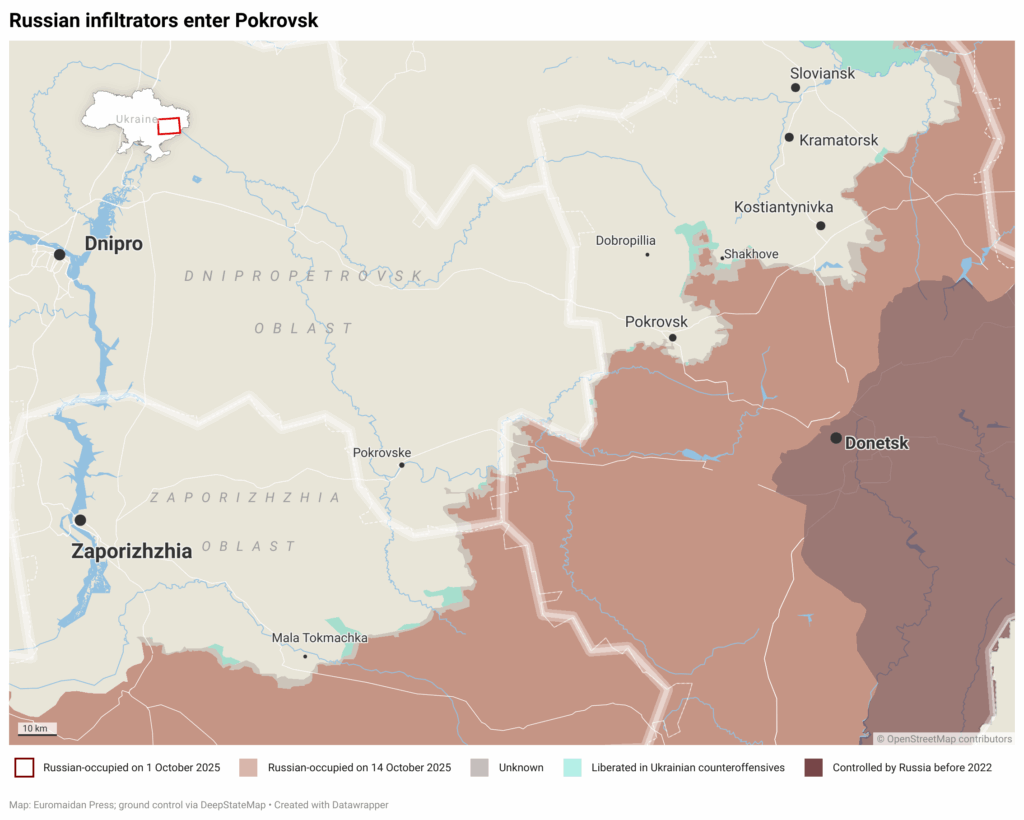
Both Russian and Ukrainian infantry are going to be even more miserable, however, as they shiver in their cold muddy trenches and trudge through deepening winter mud.
The weather turned in early October. Not coincidentally, that's when Russian field armies around Pokrovsk finally deployed the hundreds, if not thousands, of tanks and other armored vehicles they had spent most of this year stockpiling.
Heavy vehicles are extremely vulnerable to the tiny explosive drones that are everywhere all the time along the 1,100-km front, of course. Anything that reduces the pace of drone sorties—bad weather than throws drones off course and obscures their sensors, for example—is a boon to vehicle crews.
“Russian forces are trying to carry out mechanized assaults under weather conditions unfavorable for UAV operations, while Ukrainian troops are repelling them,” the pro-Ukraine Conflict Intelligence Team noted.
The weather was bad in early October, but maybe not bad enough. Despite the overcast, Ukrainian drones detected and—with the help of artillery and mines—halted all four major Russian mechanized assaults around Pokrovsk in recent weeks.
"We have terrible weather conditions," Ukrainian drone operator Kriegsforscher reported after helping to knock out 16 vehicles on 9 October. "But we still managed to find an opportunity."
As I mentioned in my previous tweet, we have terrible weather conditions.
— Kriegsforscher (@OSINTua) October 9, 2025
But we still managed to find an opportunity: together with other units only for a couple of days we destroyed:
• 4 tanks;
• 6 IFVs;
• 5 trucks and 1 pontoon bridge.
20/1 CAA/TA has a lot of scrappic.twitter.com/j2sgGXMGir
The Russians' fortunes may improve as the winter sets in, however.
"Rain and fog ... hinder Ukrainian reconnaissance UAVs from detecting [Russian] armored vehicle columns in advance," the pro-Ukraine Conflict Intelligence Team explained.
If more Russian armor can get across the wide drone kill zone and land infantry inside Ukrainian territory, the Russians may be able to accelerate their slow pace of advance around Pokrovsk as October turns into November.
But it's not all bad news for Ukraine. The same weather that obscures Russian tanks from Ukrainian drones also obscures Ukrainian supply trucks from Russian drones.
This is especially important for Ukrainian trucks trying to roll south into Pokrovsk past the 40-square-kilometer salient Russian forces carved out of Ukrainian lines near the village of Dobropillia back in August.
The rain and fog "may enable the [armed forces of Ukraine] to more safely use the road near the Dobropillia salient because the airspace contains fewer enemy drones on such days," CIT predicted.
So, while more Russian tanks attack, Ukrainian defenders around Pokrovsk may have more supplies, more shells, more missiles, and more capacity to resist.
The only clear losers are the infantry on both sides, who were already struggling in the cold mud that defines the early winter in eastern Ukraine—and are now about to struggle harder. With drones patrolling tens of kilometers in both directions from the line of contact, the journey to the line for an infantryman is "now a full-scale trek," one Russian blogger moaned.
It's often unsafe for vehicles, so the infantry walk. "With all your gear, about 30 kilos of it, you're dropped off 10 to 15 kilometers from the point where you'll be fighting," the blogger added. "In some areas, the trek can be up to 30 kilometers."
Imagine walking with that weight when it's cold and wet. Now imagine that only the miserable cold and wet are your best defenses against the drones that still stand a pretty good chance of killing you.
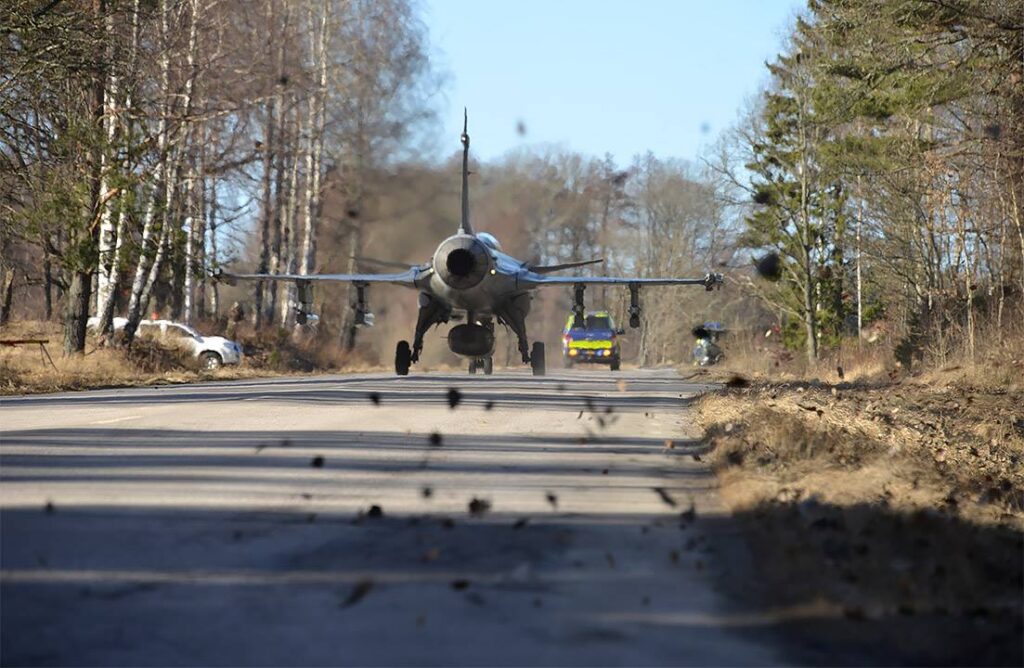
The Ukrainian air force may eventually re-equip with Saab Gripen E/F fighters.
The nimble supersonic jets are uniquely suited to the Ukrainian way of war, which requires the air force to spread far and wide across small airfields and even roadway airstrips in order to avoid attack.
This matters because Ukraine's jets keep flying by avoiding big, vulnerable air bases—dispersing instead to highways and hidden strips across the country. But this survival strategy puts intense pressure on the aircraft. While Ukrainian brigades can coax American F-16s into this nomadic existence, it requires mobile support teams and kid-glove treatment.
The Gripen doesn't—it's built for rough-field warfare. Sweden designed the jet in the 1980s specifically to survive Soviet strikes on air bases, operating instead from highway strips scattered across the country.
Ukrainian Pres. Volodymyr Zelensky met with Swedish Prime Minister Ulf Kristersson in Helsinki on Wednesday in order to discuss the deal. "We expect that the future contract will enable us to obtain at least 100 of these jets," Zelensky said.
"We are looking into how this can be financed," Swedish defense minister Pål Jonson said of the potentially multi-billion-dollar acquisition.
It could take years for the first Gripens to arrive in Ukraine. If and when they do, they should fit right in.
The Swedish fighter is specifically designed to fly from short, rough airstrips—just like the Ukrainian air force's current, mostly ex-Soviet, fighters do—all in order to avoid detection by Russian drones and bombardment by Russian missiles.
This difficult but critical dispersal practice is the main reason why the Ukrainian air force is still in the fight 44 months into Russia's wider war. Many of the jets the Ukrainians have lost have been hit at the air force's main air bases, which are big, vulnerable and well-known to Russian strike planners.
The Ukrainian jets that have survived are the ones that have avoided the big bases—and flown from small civilian airfields and long stretches of highway, instead.
Key survival factors for Ukrainian aircraft:
Ukraine's main warplane, the Soviet-made Mikoyan MiG-29, is adept at dispersed operations.

As a supersonic MiG-29 touches down on its reinforced landing gear, doors close over its gaping air-intakes while gates open on top of the intakes. This system prevents rocks and other "foreign object debris," or FOD, from wrecking the jet's engines while it's operating from a dirty airstrip or roadway.
Similar anti-FOD systems are standard on the Soviet-style jets that equip Ukraine's air force: not just MiG-29s, but also Sukhoi Su-24 bombers, Su-25 attack jets, and Su-27 interceptors.
The planes' robustness and short runway requirements—a MiG-29 needs just 300 m or so—is why they've endured in Ukrainian service.
Ukraine's Western-made planes are needier and less rugged. American-designed Lockheed Martin F-16s in particular are ill-suited for ops from debris-cluttered runways.
They have no anti-FOD system. And their gaping under-fuselage intakes practically gobble up dirt and rocks. While Ukrainian brigades do fly the F-16 from dispersed airstrips, they do so with great care. It's not for no reason the air force has assembled special mobile units with all the support equipment you'd need to launch and land a delicate F-16 on a dirty runway.
Equally vexing, an F-16 needs 800 m of runway to take off at full weight.
The Gripen, by contrast, is a tough, spritely little plane—making it better for dispersed ops. It doesn't have the anti-FOD doors that a MiG does, but it does boast tall landing gear that helps keep it clear of debris. And thanks to its thrust-reverser and canards, which double as brakes, it can operate from 500 m of clean surface.
Sweden's approach came from its "Bas 90" system—a network of highway strips, hidden fuel caches, and minimal infrastructure designed to survive Soviet bombers wiping out traditional air bases. Swedish planners envisioned mechanics working from trucks while Gripens took off from 500-meter stretches of road between refuelings.
Follow Euromaidan Press on Google News! YOUR SUPPORT = OUR VOICEThat Cold War nightmare never materialized for Sweden. But Ukraine is living it now.
| Aircraft | Runway length needed | FOD protection | Design purpose | Ukrainian fit |
|---|---|---|---|---|
| MiG-29 | ~300 m | Top-mounted intake doors | Soviet rough-field ops | Excellent - proven in service |
| F-16 | ~800 m | None | Prepared NATO airfields | Poor - requires special care |
| Gripen E/F | ~500 m | Tall landing gear | Swedish Cold War dispersal doctrine | Excellent - purpose-built |
 Scroll horizontally to see all columns on mobile
Scroll horizontally to see all columns on mobile
As long as Russia is the main threat to Ukrainian security, Ukrainian warplanes must operate within range of long-range drones and cruise and ballistic missiles that can turn big air bases into kill zones.
Dispersal will be the key to their survival. The fighter that disperses the best is the obvious best choice for Ukraine's main future warplane.
The jet Sweden designed to hide from Russian missiles in the 1980s may soon face them for real—40 years later, over Ukrainian skies rather than Swedish forests.
Follow Euromaidan Press on Google News! YOUR SUPPORT = OUR VOICE| Aircraft | Runway length needed | FOD protection | Design purpose | Ukrainian fit |
|---|---|---|---|---|
| MiG-29 | ~300 m | Top-mounted intake doors | Soviet rough-field ops | Excellent - proven in service |
| F-16 | ~800 m | None | Prepared NATO airfields | Poor - requires special care |
| Gripen E/F | ~500 m | Tall landing gear | Swedish Cold War dispersal doctrine | Excellent - purpose-built |
 Scroll horizontally to see all columns on mobile
Scroll horizontally to see all columns on mobile
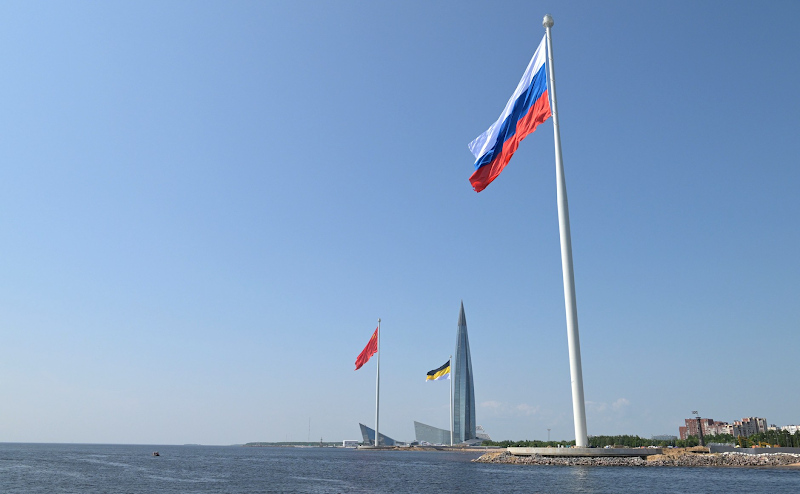
Russia’s steel industry is facing its worst crisis of the decade as thousands lose jobs and incomes fall. The sector employs around 700,000 people and accounts for nearly one-fifth of the country’s industrial output, Ukraine's Foreign Intelligence reports.
Falling demand, high credit costs, and worsening financial results have forced most Russian steel plants to reduce personnel. The sector, which lost a third of its exports due to sanctions and closed Western markets, is experiencing a crisis comparable to the 1990s.
Key production declines in 2025:
According to Russian steel company Severstal’s financial report, net profit in Q3 2025 fell threefold to $160.4 million, and over the first nine months of the year, it dropped 57% to $614.4 million. Revenue fell 18% for the quarter and 14% for nine months.
Free cash flow turned negative, at -$262.4 million from January to September, and cash reserves nearly halved, from $1.59 billion to $892 million. The board decided not to pay dividends for Q2 and Q3 2025.
Amid a 15% drop in domestic demand and declining export profitability, Russian steel companies expect continued deterioration in financial performance in Q4 2025.
Follow Euromaidan Press on Google News! This small action sends a huge signal and helps a lot
Ukraine sets clear goals. President Volodymyr Zelenskyy has tasked Ukrainian military leadership with producing at least half of all weapons supplied to the frontlines by the end of 2025.
He also announced a transformation of the National Security and Defense Council (NSDC) apparatus, aimed at strengthening efforts in this direction.
The resident shared these updates following a meeting with NSDC Secretary Rustem Umerov, outlining three key priorities of Ukraine’s defense policy.
The top priority, Zelenskyy said, is strengthening the Ukrainian Air Forces.
“This is part of a strategy to create strong Air Forces capable of guaranteeing our state’s long-term security,” Zelenskyy stated.
New defense agreements are being prepared to expand the capabilities of Ukraine’s combat aviation.
The second priority is active diplomacy and aligning Ukraine’s defense requirements with international partners.
This week, meetings are planned with leaders of the European community and the Coalition of the Willing, where Ukraine will present an updated list of requests, including:
The third priority focuses on strengthening the defense-industrial component and preparing for upcoming NSDC sessions.
“To fully meet defense needs, a transformation of the NSDC apparatus will be carried out,” Zelenskyy said.
Oh hai
It’s you again
I thought I’d dealt with you
Written your ugly face into oblivion
I know, I did too much
Yesterday
I was happy to finally do things
That had been nagging at me for months
OK, I didn’t do what was planned
But hey
I did do stuff
That needed to be done
So I guess it’s my fault
Isn’t it
I should have known better
I should have done less
I should have known
That I’d pay today
And forced myself
To stop, to rest, to stick to the plan
Exciting plan of course
Taxes
And today I’m useless
Headache in the background
Shopping carts full to the brim
With colourful jigsaw puzzles I covet
I’m working tomorrow
I need to recover
I could use sympathy, you know
Or maybe even congratulations
For not hitting « buy »
For getting the message when I woke up
For not trying to push myself
For writing off the day
My taxes can wait
They’re already late
Let me off the hook for once
« It’s your fault it’s your fault it’s your fault »
Why can’t you just hear
That this is the bug in my programming
I’m looking for workarounds
But you don’t seem to care
You just keep showing up, Guilt
I won’t call you my friend
Though you and I
Are well acquainted
Be gone with you!
I’m fed up and tired
Go take a hike
Without me of course
To the end of the trail
That leads off the cliffs
I can tell you for sure
That you won’t be missed
J’y bossais déjà, mais depuis mon accident, je prends des cours avancés de lâcher-prise. Avoir du temps mais ne pas avoir d’énergie, donc renoncer. Dire non à des propositions. Dire oui en sachant que j’aurais dû dire non, faire quand même et payer derrière, me promettre que la prochaine fois je dis non. Non aux autres c’est des fois pas toujours simple, mais le pire c’est de devoir me dire non à moi.
J’ai déjà assez de “je veux” pour faire déborder une vie sans commotion, à la base. Alors là, je vous laisse imaginer.
Ne pas aller en randonnée. Ne pas aller au judo. Ne pas ranger les cartons qui attendent pourtant. Ne pas faire mon admin qui commence à peser sur ma liste des tâches. Ne pas voir des gens – des gens que j’aime et que j’aimerais voir, mais mon quota d’énergie disponible est épuisé ou pris par autre chose.
Faire des projets et les défaire au fur et à mesure. Annuler. Décommander. Déplacer. Dire “ah oui ça je vais faire”, pas juste à moi, mais à l’autre, et ne pas faire, semaine après semaine. C’est pas nouveau, ça, vous me direz, mais c’est d’autant plus cuisant que je fais des efforts immenses pour justement ne plus garder que le minimum. Même le minimum, à mes yeux, c’est trop pour ma vie juste là.
Voir passer les mois amorphes et regarder en arrière: certes, une ou deux choses de faites, une poignée peut-être, mais surtout de la convalescence, de la récupération, du repos.
Ah, le repos. Le Graal, l’objectif, le truc à apprendre, en plus du lâcher-prise. Mais c’est pas simple. Y’a un ou deux films sympas, genre Flow et Moana, que je veux regarder depuis des mois. Parce qu’au moins quand je regarde un film, ou une série, je suis pas en train d’agiter mon cerveau à faire autre chose. Puzzles? Bien sûr – ça fait des semaines que j’ai tout le temps “mieux à faire” que de me mettre au suivant. Y’a toujours des choses plus importantes à faire que de me reposer. Ranger le coin de bordel à l’entrée par exemple. Mettre les habits propres de la lessive de la semaine dernière dans l’armoire. Ecrire un article sur mon blog (oups).
Lâcher prise, aussi, quant à l’illusion que “gérer sa vie” est un objectif réaliste. C’est nouveau comme idée, ça. Mon perfectionnisme, il se manifeste moins dans les choses que je livre ou que j’accomplis que dans ma façon d’organiser ou de gérer. L’organisation ou la gestion, ça doit être fait “juste”. J’aspire à la sérénité que m’apporterait une vie où je n’ai ni piles de bordel à ranger ni piles d’habits à plier ni tas d’admin à faire ni légumes morts au fond du frigo que j’aurais dû cuisiner. Une vie un peu sous contrôle. Pas rigide, hein. Juste, gérée – comme quand on arrive à la gare avec une minute ou deux en rab, qu’on peut marcher tranquille, même profiter de regarder autour de soi, de respirer un peu.
Je regarde autour de moi, et je crois que personne n’a ça. Et je me dis que les vies de 2025, en fait, si ça se trouve c’est juste pas possible de réussir à suivre. Il y a toujours des choses qui vont nous échapper. Je dois m’avouer que je ne suis pas encore prête à lâcher prise, là, je m’accroche à cette illusion: il doit bien y avoir un moyen de gérer tout ça pour que ça roule. Il faut juste que je le trouve.
Lâcher prise: de retour au travail cette semaine. Je veux dire et redire que mon employeur, dans toute cette histoire, a été exemplaire. Soutien, empathie, zéro pression, un vrai allié. Je n’ose pas imaginer que qu’auraient été ces sept derniers mois avec un employeur moins compréhensif. Mais lâcher prise, parce qu’au moment de mon accident, j’étais arrivée à un rythme de croisière dans mon projet, j’avais réussi à commencer à mettre en mouvement des choses, j’avais planté des graines, lancé des pistes, activé des contacts.
C’est comme si en février-mars j’avais préparé mon joli jardin: retourné la terre, identifié quoi planter où, mis mes semis, commencé à regarder les petites pousses sortir de terre. Et maintenant, je retrouve mon jardin après sept mois laissé à l’abandon, je ne sais plus ce que j’ai planté où, il y a des mauvaises herbes partout, la moitié des semis sont morts, il y a des trucs qui poussent mais que je n’arrive pas à identifier. C’est dans l’ordre des choses vu la nature de mon job. Mais là, je ne peux pas juste revenir et continuer à m’occuper du joli jardin. Je dois d’abord identifier ce qui a poussé, ôter les mauvaises herbes, voir s’il y a des petites plantes à sauver ici ou là, s’il est encore temps de planter pour une récolte tardive…
Allez, je laisse la métaphore du jardin, faut pas la pousser trop loin, mais là aussi, qu’est-ce qu’il y a à lâcher prise.
Accepter ce qui est hors de mon contrôle.
En l’occurrence, mes limites. On choisit pas ses limites. On choisit ce qu’on en fait, si on les écoute, déjà, si on les respecte, ensuite.
Et pour la majeure partie de cette année, non seulement mes limites se sont manifestées de façon à ce que je ne puisse pas les ignorer, mais en plus de ça, elles ont déménagé pour venir s’installer juste devant ma porte. Je n’ai qu’à ouvrir, et hop, elles sont là.
Alors, ne dramatisons pas: je vais bien, dans l’ensemble, j’ai passé un cap il y a deux mois ou quelque chose comme ça, je suis en reprise de travail et je suis prête pour (pas comme en avril où j’y suis allée en me disant qu’on n’était jamais à l’abri d’une bonne surprise, mais que ça me semblait tout de même bien chaud). Je reprends mes activités.
Mais toujours à vitesse réduite – comme le travail.
C’est ultra frustrant. C’est ultra frustrant de voir tous ces mois “perdus”, moi qui ressens toujours très fort l’urgence de le vie parce que la mort est à nos trousses et qu’on ne sait pas quand elle nous rattrapera. J’ai appris jeune que ça pouvait être très tôt. La vie n’a cessé de me le confirmer.
Mais je sais que si je veux pouvoir être active à l’avenir, je dois apprendre à ralentir. Donc oui, bien sûr, ces mois ne sont pas “perdus”. J’ai appris et j’apprends encore: à ralentir, à lâcher prise, à dire non, à accepter que je ne peux pas faire ceci, ni cela, ni ça.
Je me répète, vous trouvez?
Après sept mois de ça, et c’est pas fini, je crois que je peux me répéter un peu.
Je pense à des gens, j’ai envie de les voir, mais je m’arrête avant de lancer une invitation ou une proposition, parce qu’avant il y a: le sommeil, manger correctement, avoir un minimum d’activité physique, gérer mon ménage et mon admin sans griller mes neurones, m’occuper de mes chats et de ma santé (sérieux des fois j’ai l’impression que gérer sa santé et son admin c’est déjà un 50%), essayer d’aller au judo et au chant (ce qui implique: m’organiser pour avoir assez d’énergie à ce moment-là), faire un peu de place pour mes proches, ne pas complètement délaisser la communauté DF, me reposer… et maintenant, on rajoute 30% de travail, pour commencer.
Ça c’est juste la base.
Alors je me rends bien compte que la complexité de ma vie a un impact direct sur la complexité de sa gestion, que ce soit côté temps ou admin.
Lâcher des choses? Lâcher prise. Mais quoi? Pas pour le moment.
Je m’accroche encore à l’idée qu’il y aura moyen de faire fonctionner tout ça.
Et donc aujourd’hui, j’ai lâché prise: dans le train en rentrant de ma première journée de travail au bureau depuis ma reprise, j’ai sorti mon calendrier, j’ai posé une plage d’admin, en me disant “allez hop je fais une heure d’admin je vais régler des trucs qui trainent”, puis une petite pause, puis une autre plage pour ma “correspondance” (je vous dis pas le nombre de gens à qui je dois répondre un truc ou un autre), et puis je vais aller au judo, ça le fait, le vendredi le cours commence toujours un peu en retard, donc si je quitte la maison à 17h45 ça ira.
Lâché prise, dites-vous? Ça ne ressemble pas trop à ça. Et vous avez raison. Lâcher prise, c’est ce qui est venu après, quand je suis descendue du train chercher mon vélo, après avoir réalisé que j’avais quand même un sacré coup de barre (c’était l’heure des médics, mais quand même), que j’avais fermé mon ordi parce que les phrases que je lisais sur l’intranet n’atteignaient plus mes neurones, que j’étais au bout de ma première semaine de reprise de travail et que je n’avais pas trop mal à la tête mais que peut-être, peut-être, ce serait sage de me reposer d’abord un peu.
Donc j’ai lâché prise: j’ai envoyé valser la plage d’admin, la correspondance, et même le judo. Ce soir je me donne un seul objectif: faire les courses. C’est tout. Si je liquide un ou deux petits trucs d’admin qui me chatouillent le bout des doigts, c’est du bonus (j’ai fait: deux paiements, envoyer une facture pour remboursement, 5 minutes chrono). Si je suis inspirée pour écrire un truc, j’écris – c’est plutôt reposant, en fait, car pour moi c’est un moyen de penser tranquillement, plus lentement parce qu’il faut écrire. Ecrire, ça canalise mes réflexions.
Les habits à ranger, qui attendent depuis plus d’une semaine, ils attendront. La pile de courrier à moitié ouverte, le coin en bordel à l’entrée, les légumes au fond du frigo: ils ne sont pas à ça près. Je lâche prise. J’accepte que juste là, me reposer est plus important que “faire”.
Enfin, j’essaie.
Je peine à trouver du temps pour écrire, ça c’est pas nouveau. Ce qui est nouveau, c’est que je me suis rendu compte, ces derniers jours, que quand j’écris pas il y a une sorte d’accumulation de charge mentale qui se crée. Pas juste de “l’activité d’écriture” remise encore et encore à plus tard, mais du contenu de ladite activité d’écriture qui s’entasse dans mon cerveau déjà bien chargé.
Au-delà de la pile d’articles en gestation dans ma tête, je me suis dit que ça me ferait peut-être du bien de juste partager ici ce qui vient. C’est pas la première fois que je fais ça, évidemment. Mais si on regarde, je suis sûre qu’on verra que c’est un type de publication qui vient souvent après une période de sécheresse rédactionnelle. C’est probablement pas pour rien.
Et puis, depuis mon accident, j’ai au fond peu réussi à donner des nouvelles de comment se passaient les choses et ma vie. On va commencer par là.
Lundi, je reprends le travail, à temps très partiel les premières semaines, déjà, puis on avisera (je refais le point avec le neurologue à la fin du mois). Après sept mois d’arrêt complet, il est temps. Je crains un tout petit peu la “mauvaise surprise” côté fatigue, parce que regardons les choses en face, en sept mois j’en ai collectionné, y compris une tentative prématurée de retour au travail à Pâques. Quand j’y repense maintenant, ça me paraît surréaliste. Au fond, toute cette histoire me paraît surréaliste. Parce que, comme je l’ai déjà mentionné, il y a un large pan de ma vie où je me vis comme “tout à fait normale”. Mais s’il y a ça, c’est aussi grâce au fait que je ne travaille pas, que mes activités sont réduites, que je ne mets pas de réveil le matin, que je peux faire une sieste si j’ai besoin. C’est quand même une période de vie bien étrange.
Au-delà de mes réflexions de fond sur le sens de ma vie (il faudra que je vous parle de la Révélation des Bois du Jorat), mon avenir professionnel à moyen terme, la façon dont je gère mes activités, mes relations et ma fatigue, je réfléchis beaucoup aux outils qui nous permettent de nous connecter les uns aux autres en ligne. Ce n’est pas nouveau, comme intérêt – on pourrait même dire que c’est un des fils rouges de ma vie – mais la suspension de mon compte Facebook fin août m’a donné un coup de pied aux fesses salutaire pour me pencher sérieusement sur la possibilité de construire un écosystème d’outils et de plateformes ouvert, qui ne soit pas régi par la logique capitaliste du profit à tout prix.
Au début il y avait le blog, pourrait-on dire (pas tout à fait vrai, mais quand même un peu), et il y a quelque chose d’assez magique dans le fait de pouvoir jardiner son petit coin à soi d’internet tout en étant en interconnexion avec autrui. Mais tout le monde n’est pas jardinier. Certains veulent juste avoir quelques pots sur leur balcon, ou admirer les jardins des autres, ou acheter quelques fleurs coupées. Il faut trouver un moyen d’amener ensemble ces différentes personnes, ce que fait une plateforme comme facebook, mais en limitant les jardiniers à une petite parcelle bien délimitée qui ne leur appartient pas, genre jardins familiaux. J’ai rien contre les jardins familiaux, mais les vrais sont conçus selon le modèle associatif ou coopératif, pas gérés à la façon d’un gouvernement totalitaire par une grosse entreprise capitaliste. Je pense qu’on peut creuser et filer encore un peu cette métaphore.
Si ce sujet vous intéresse, je vous invite à lire ma série “Rebooting the Blogosphere“, en la mettant dans un traducteur si l’anglais est un obstacle. C’est un peu technique par moments, mais pas que.
Donc, difficile de trouver le temps d’écrire, comme toujours. A quoi me suis-je occupée?
Après le week-end du Jeûne, j’ai eu une semaine très étrange où j’ai dormi une bonne heure de plus par nuit en moyenne que d’habitude, avec maux de tête en continu et sensation d’avoir passé sous un rouleau compresseur dès le réveil – zéro énergie. Ça s’est gentiment arrangé au bout d’une semaine, dix jours. J’ai initialement pensé que j’en avais trop fait durant le week-end (une “petite balade” qui s’est transformée en randonnée de 5h30 sur un mini sentier au pied des falaises de l’Ardèche), mais à ce stade le consensus semble être que ça devait être un virus. On ne saura probablement jamais. Mais bref, une semaine durant laquelle j’avais prévu de pouvoir faire plein de choses, parce que j’allais vraiment beaucoup mieux depuis quelque temps, “perdue” au final. Et ça m’a stressée, vu la reprise de travail programmée. Mais là ça va, c’est passé.
Oscar a eu chaud (et moi aussi): pancréatite, anorexie, j’ai dû lui faire mettre une sonde oesophagienne (sinon il ne s’en sortait pas). Ça n’a pas été simple a gérer, ça a été stressant (d’autant plus avec mon absence durant le week-end du Jeûne), mais il s’est bien remis et a maintenant repris sa petite vie, avec 300g en moins. Sa vie: descendre à l’eclau pour occuper la place et taper sur Juju s’il est là, se faire servir “au lit” la pâtée du matin et du soir (médics) sur mes doigts, faire un saut sur le balcon, sortir quelques fois par semaine et tenter de rattraper Juju (mais le bougre bouge vite!) ou plonger dans les buissons impénétrables, manger, boire, faire un petit brin de toilette de la patte qui reste et du museau quand ça le prend, faire la tournée des différents dodos à différents moments de la journée.
Allez, d’autres choses en vrac:
Allez, ça fait une heure et quart que j’écris, je m’étais dit une heure, je vais vous laisser là. Pour aujourd’hui. Je me suis dit que ce serait peut-être un bon exercice, de m’entrainer à faire des articles qui tiennent en une heure. Pour pouvoir me dire (oui je me dis beaucoup de choses): “OK, j’ai une heure, j’écris” – alors que jusqu’ici, pour écrire, souvent j’ai besoin d’avoir le sentiment d’avoir tout le temps du monde pour m’y mettre. Peut-être qu’il y a écrire et écrire, d’ailleurs. Je m’étais dit la même chose pour la vidéo: je veux faire plus de vidéos (maintenant que Facebook a plus ou moins tué les Lives en ce qui me concerne), mais avec une limite de temps. Vingt minutes? dix minutes? A méditer.
Comme toujours, merci de m’avoir lue si vous avez tenu jusqu’au bout. Laissez un commentaire pour me dire coucou, c’est vrai qu’après avoir été formatée Facebook pendant des années, on a parfois l’impression de bloguer dans le désert (l’intégration avec le Fediverse devrait contribuer à résoudre ce problème).
It’s funny how physical tiredness is not something one would think to question. It seems pretty obvious. We understand that if somebody has spent decades using and abusing their body, they’re going to face consequences as they get older. If you’re doing extreme running, hundreds of kilometres, or an insane amount of walking, crossing continents, your body gets worn out. We also understand that as we age, we may still be capable of doing things, but it doesn’t mean it’s a good idea to do them. For example: I can still carry very heavy loads, but if I do, my back is going to remind me the next day that I’m not 20 years old anymore.
For some reason, we do not seem to apply the same kind of thinking to the brain. Or at least, I didn’t. Although we understand that the brain has limits – everybody experiences some degree of cognitive tiredness at some point or another – we seem to think that the consequence is temporary. We need a break, we’re done for the day, we need a good night’s sleep and then we can start over. We know about burnout and that sure, of course, you need to take the time to recover if you want to function correctly again. But wear and tear over years and decades does not really seem to be on the radar.
We don’t tell somebody who keeps pushing their brain day after day, month after month, year after year, that they should ease up a bit – as we would our sport-obsessed friend who trains 6 times a week and considers “rest” a 10k run. We look at performance (what are you delivering at work), but not at effort and actual “cognitive use”.
My accident has driven home for me, in a frighteningly clear manner, that “cognitive overtraining” is as much a thing as “physical overtraining”. I’ve been “cognitive overtraining” all my life, and for most of it, unaware that I was doing it or that there was such a thing.
I am really good at pushing myself. It’s not always visible, because I have a lot of ressources (one way to put it is that I am clearly towards the right end of the IQ bell curve) and therefore compensate well for my hearing loss and ADHD. But that compensation has a cost, even if it is not visible that I am compensating. I am only now starting to measure how much effort goes into “simple” things like following conversations and managing my daily life. I am in a somewhat paradoxical situation where many of the things I receive most praise and recognition for are those that cost me the less – and those that cost me the most go completely unnoticed. This means that I have trained myself, all my life, to consider the efforts I make as “normal” rather than recognise that I am pushing myself.
This also means I have internalised the idea that when I “fail” (and by that I mean: feel tired “without reason”, don’t manage to get around to doing housework, miss parts of what is being said) it is because I was not trying hard enough. Pushing myself is the norm.
I had a moment of realisation regarding that the other day. I went back to singing practice, which I hadn’t really been able to since my accident. I was a bit tired, but I wanted to go as we were starting a new programme which contains a lot of songs I like. So I decided to go and “take it easy” – something I’ve been trying to practice these last months. Going easy. I told myself “I’ll just go and not try too hard”. Very quickly, during the rehearsal, I realised how much effort I was putting in, despite myself. Concentrating really hard to understand what the director was saying. Paying close attention to try and sing the line correctly as soon as possible, and memorise things as I went along. I usually use the time when the director is working with other registers to learn lyrics and compare musical phrases to help me remember them. It was very weird to tell myself to “just relax” when the others were working, and “nevermind” if I couldn’t hear or understand what was being said.
Earlier, some time last year I think, I realised that when I had long meetings in German at work, I really had trouble being productive the next day. But I hadn’t gone beyond “ok, plan a light day the next day” in terms of drawing conclusions. I kept thinking that the main driver of whether I could perform cognitively or not was sleep. But it’s not.
According to the neurologist who is treating me for my post-concussion syndrome, chronic cognitive overload is a clear risk factor for this type of complication. It’s also a risk factor for worse recovery after a stroke, or worse outcomes in case of cognitive decline or dementia in older age.
This has given me an awful lot to think about regarding how I’m using my brain-as-organ in my life, and how things are going to have to change. Where can I save on my brain budget? Where is it worth expending effort? What else can I put in place to have a lower “cognitive burn rate” just to get through daily life?
I’m not too bad at managing the load I place on my body – now I have to do the same with my brain.
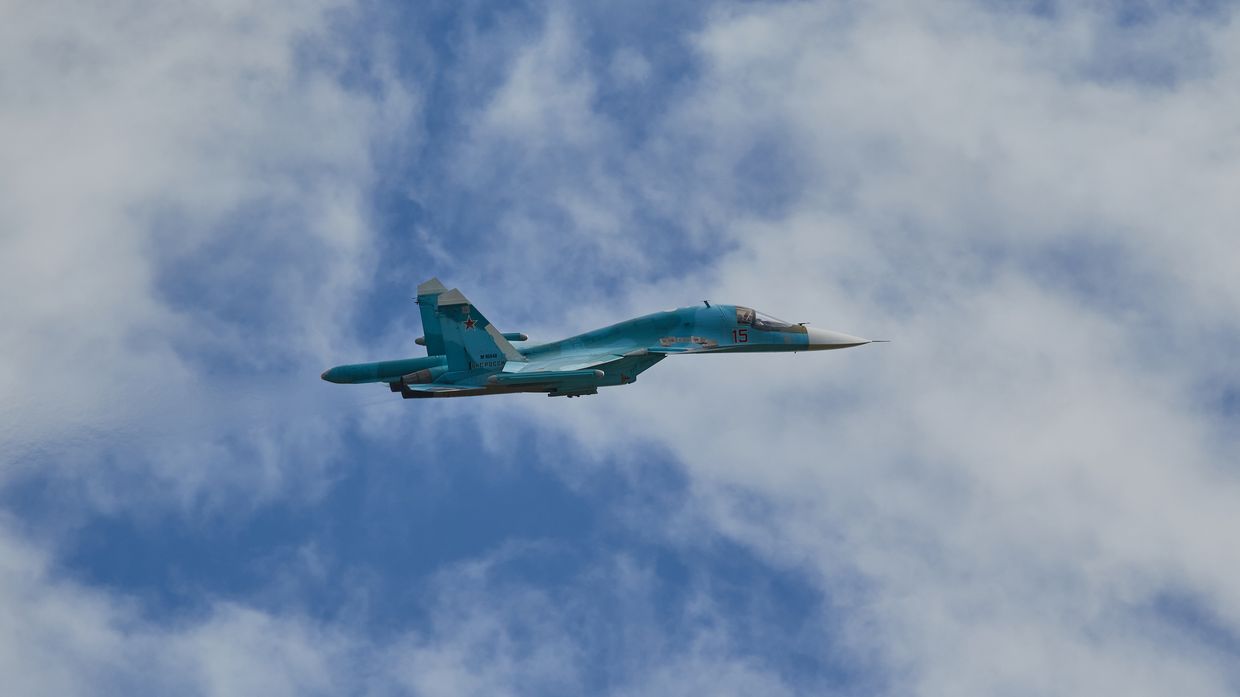
Editor's note: This is a developing story and is being updated.
A Russian SU-25 fighter jet reportedly crashed over Donetsk Oblast on June 13, Russian social media channels reported.
Videos posted on social media of the purported crash by bloggers with close ties to the Russian Air Force appear to show the plane crashing into a field after closely being followed by another fighter jet. The circumstances of the crash remain unclear as rumours swirl of Russian 'friendly fire' as a potential cause of the crash.
The Kyiv Independent cannot independently verify the crash or the details surrounding it. Neither the Ukrainian nor Russian military have commented on the reported crash.
The Su-25, a Soviet-designed close-air support aircraft developed by Sukhoi in the late 1970s, is built for battlefield survivability. It features heavy armor and can withstand enemy fire.
The aircraft has been widely used in various conflicts, including in Afghanistan, Chechnya, and, more recently, in Ukraine, where both Russian and Ukrainian forces operate the platform.
Ukraine has downed multiple Russian Su-25s throughout the war. On Feb. 8, Ukraine's military reported shooting down a Russian Su-25 near the town of Toretsk in Donetsk Oblast.
In another instance, Russia's Defense Ministry said on on March 24 that Russian Su-25 attack aircraft crashed during a routine training flight in Primorye Krai in Russia's Far East.
The incident comes less than two week following Ukraine's 'Operation Spiderweb' in which Ukrainian drones smuggled deep inside Russia and hidden inside trucks struck as many as 41 Russian heavy bombers at four airfields across the country.
 The Kyiv IndependentThe Kyiv Independent news desk
The Kyiv IndependentThe Kyiv Independent news desk